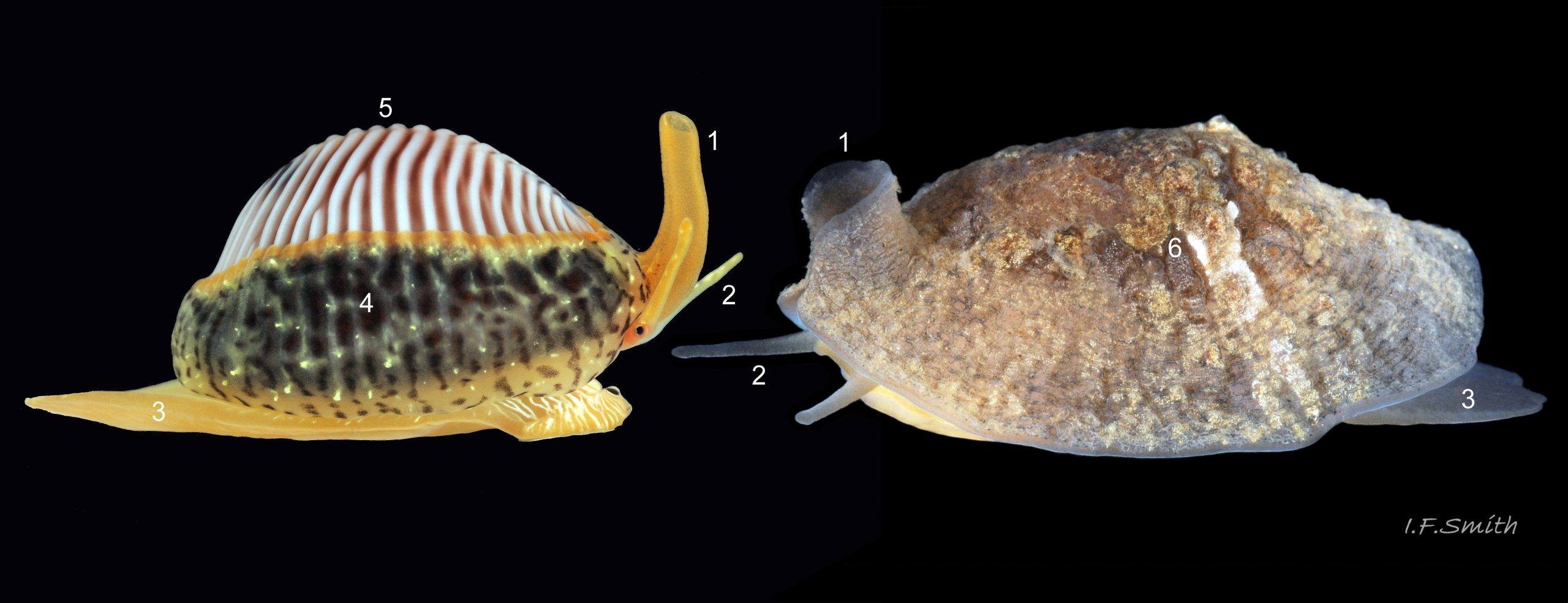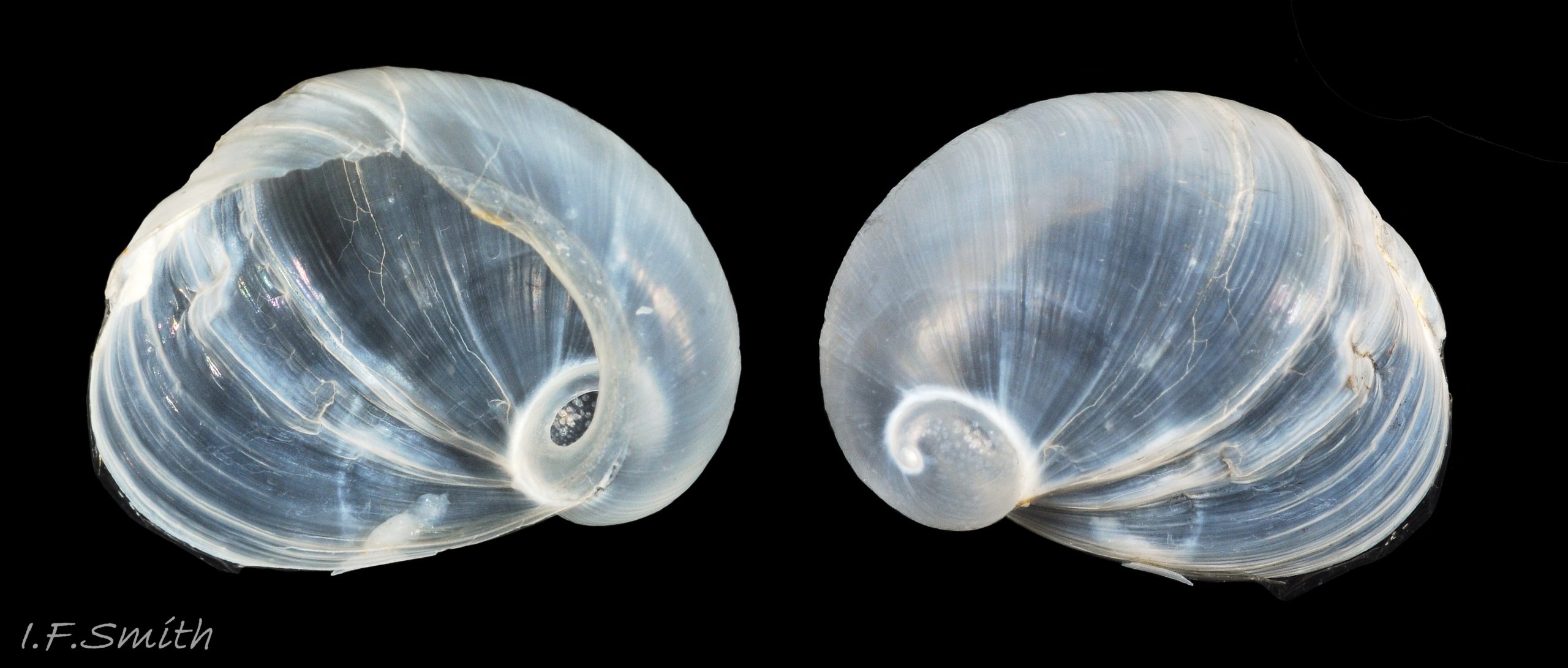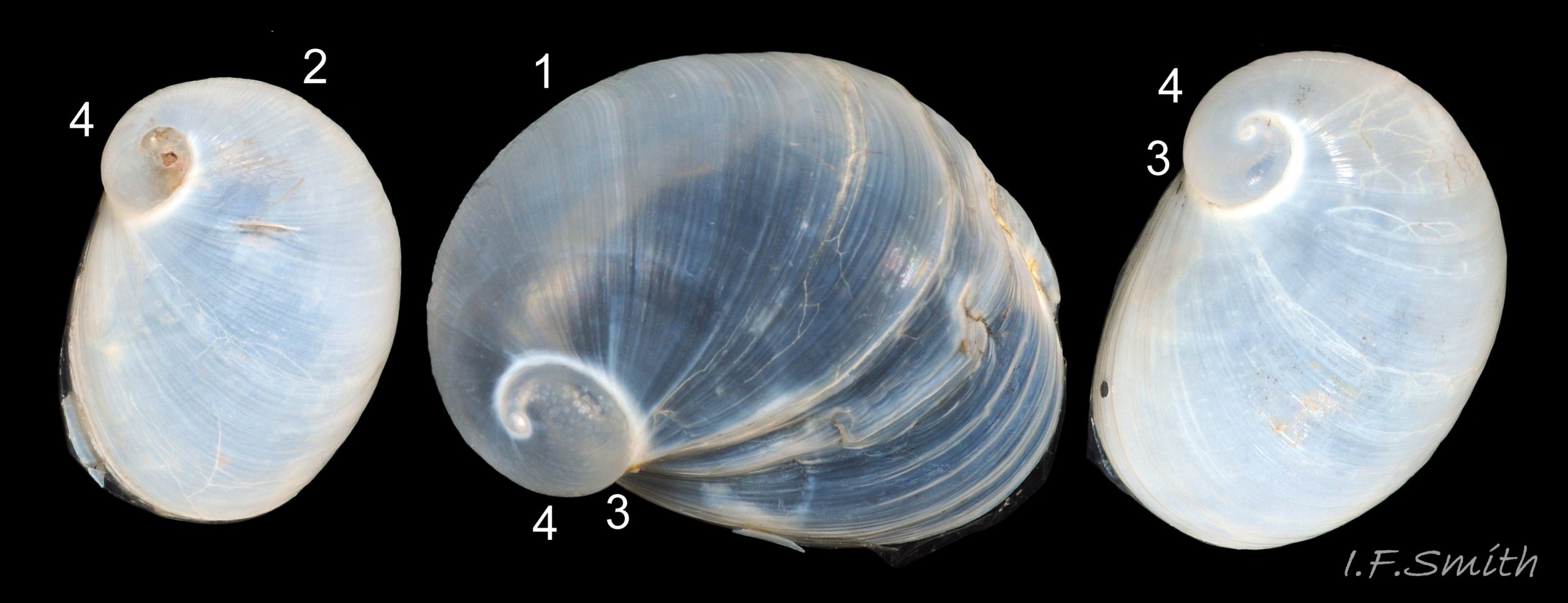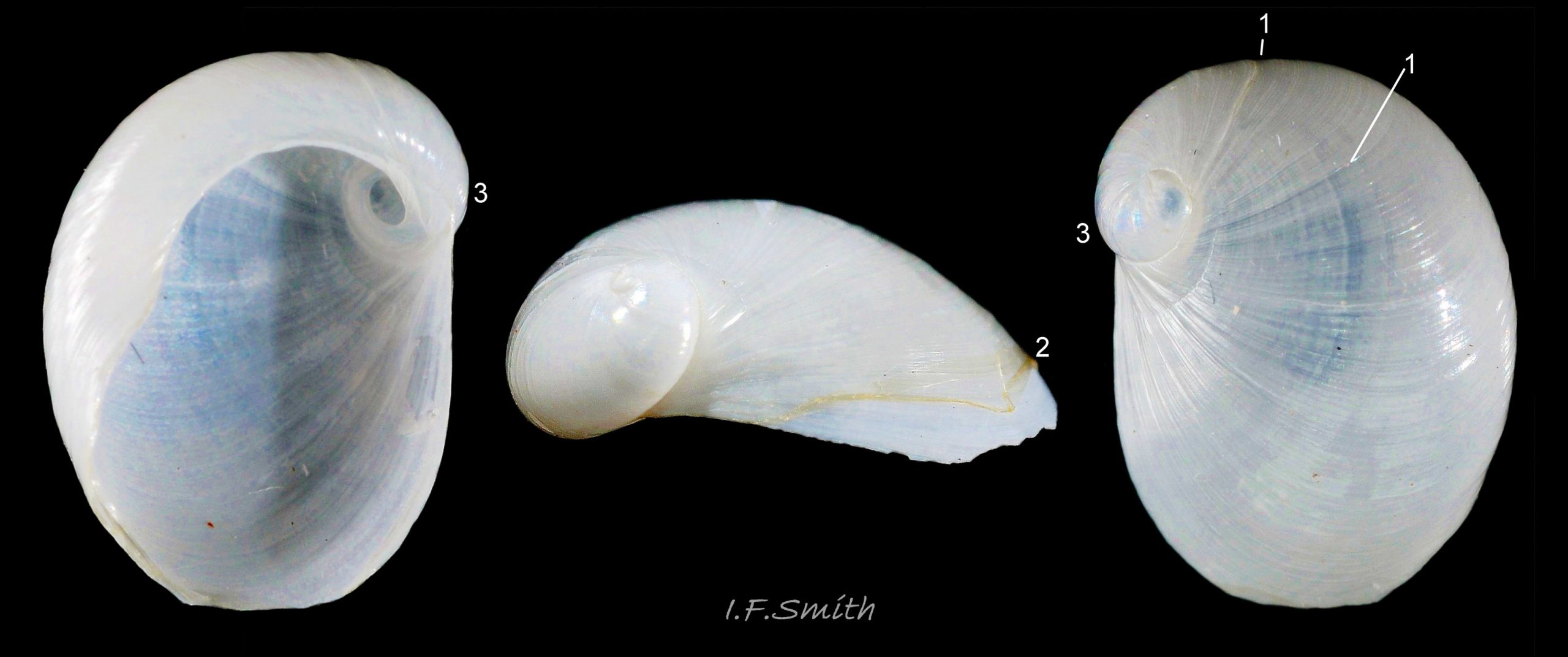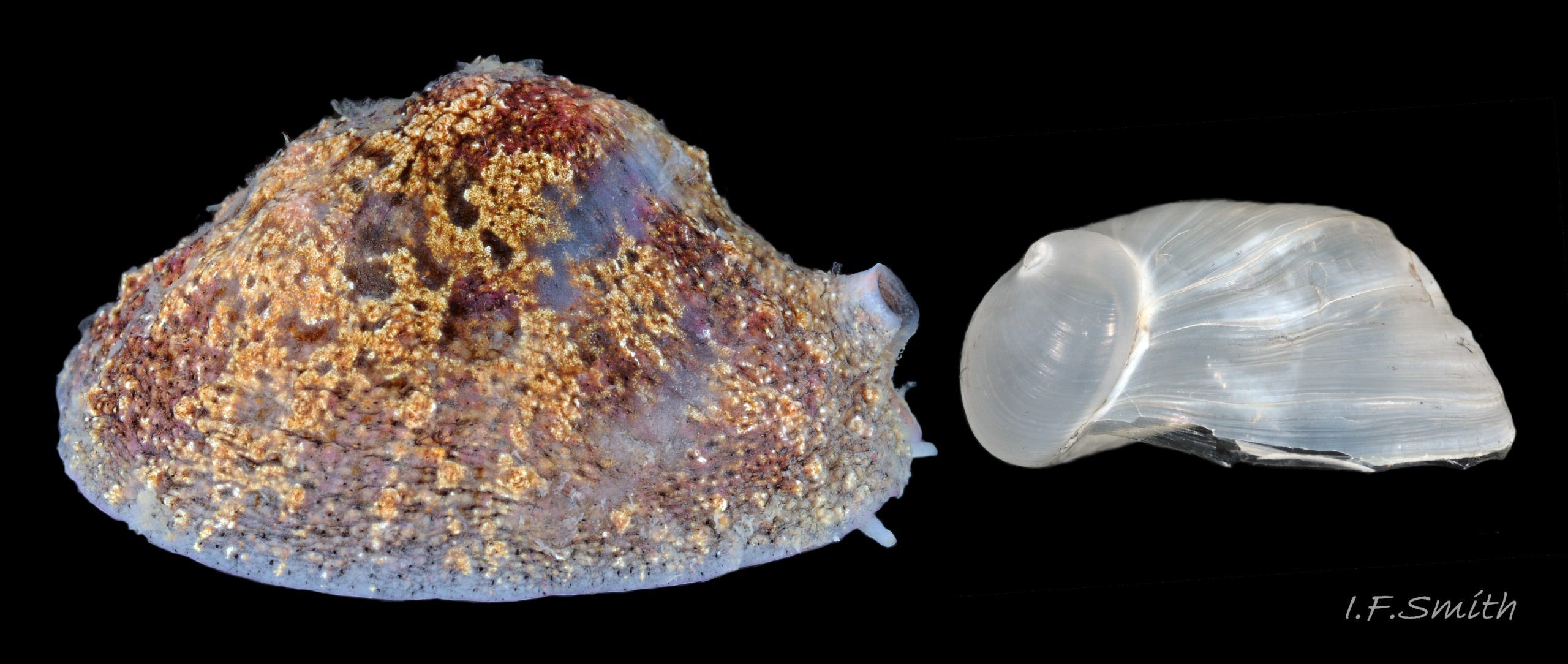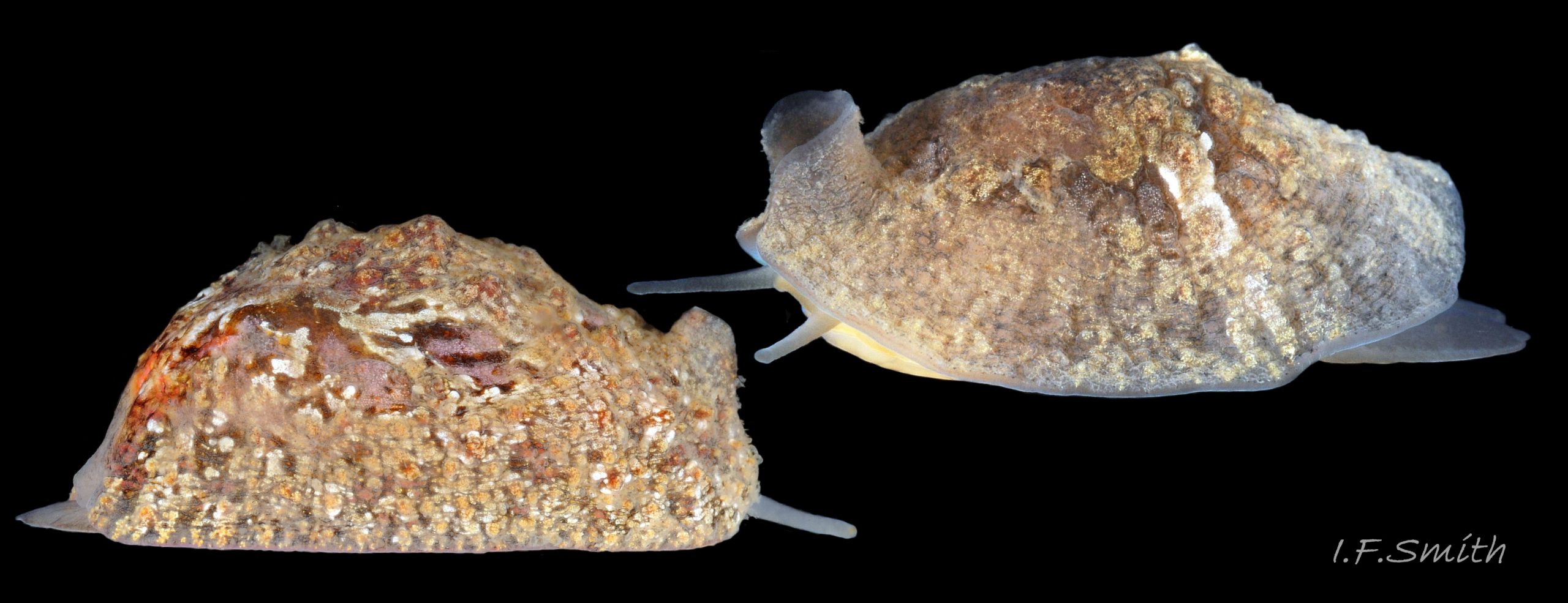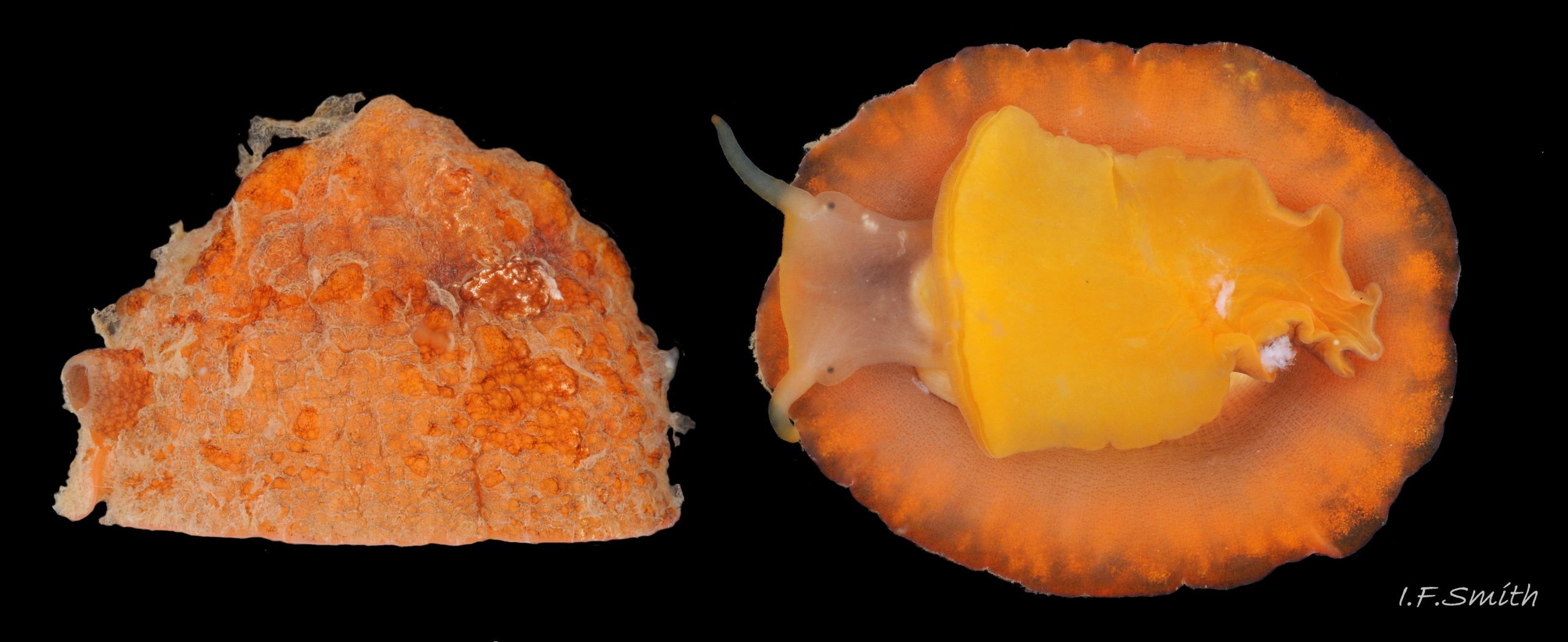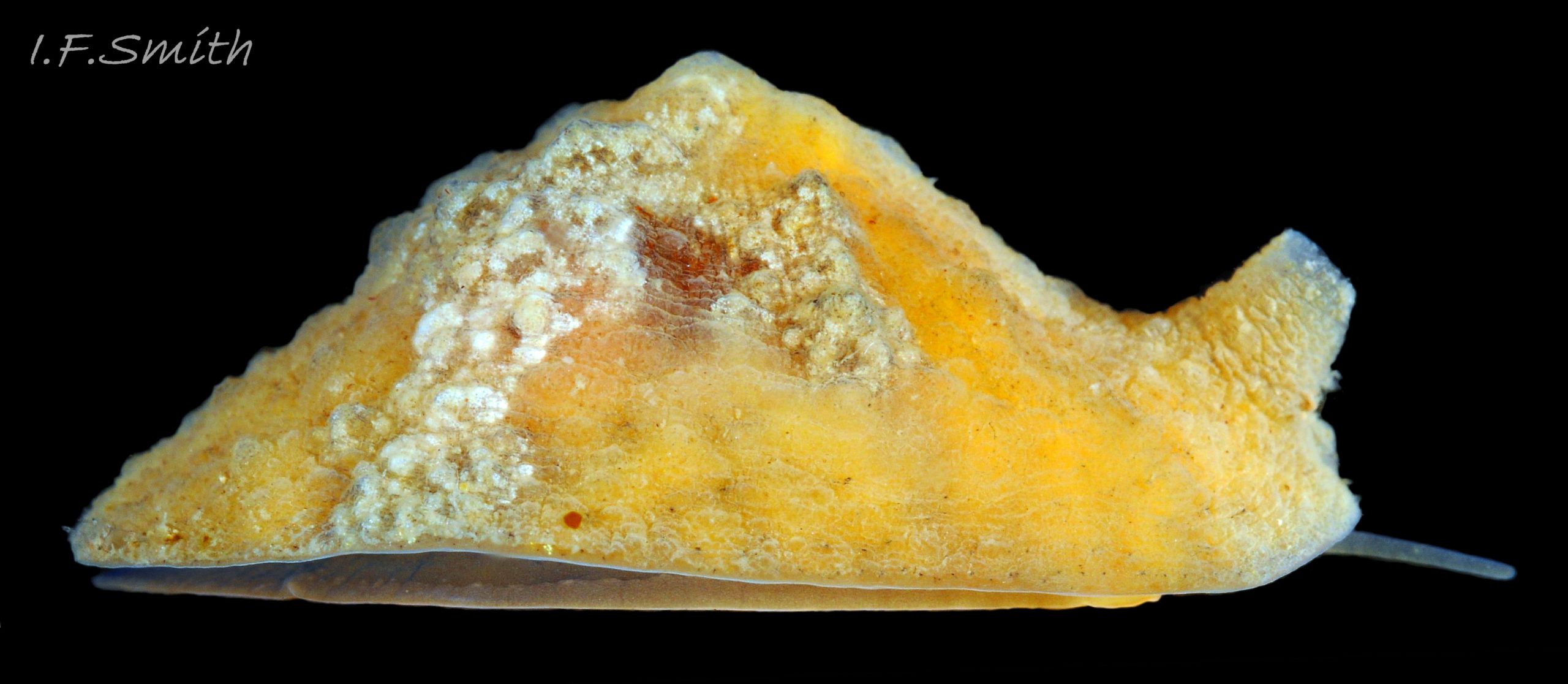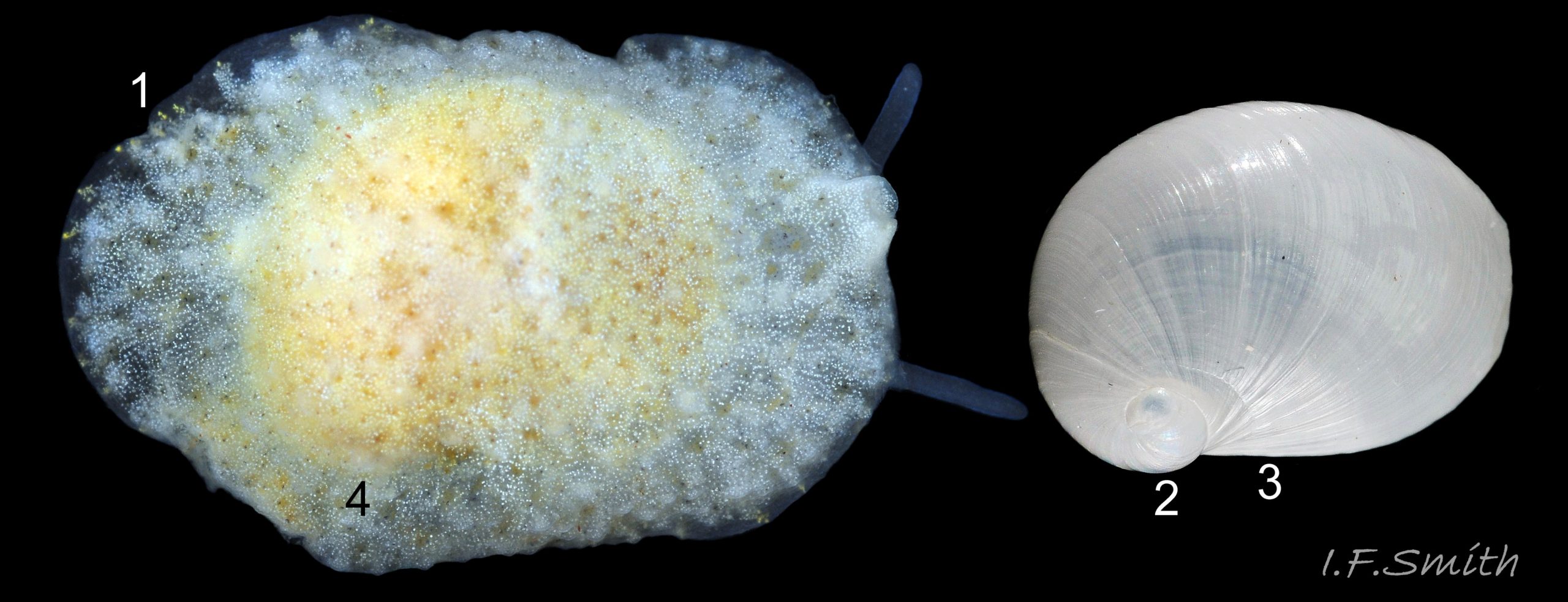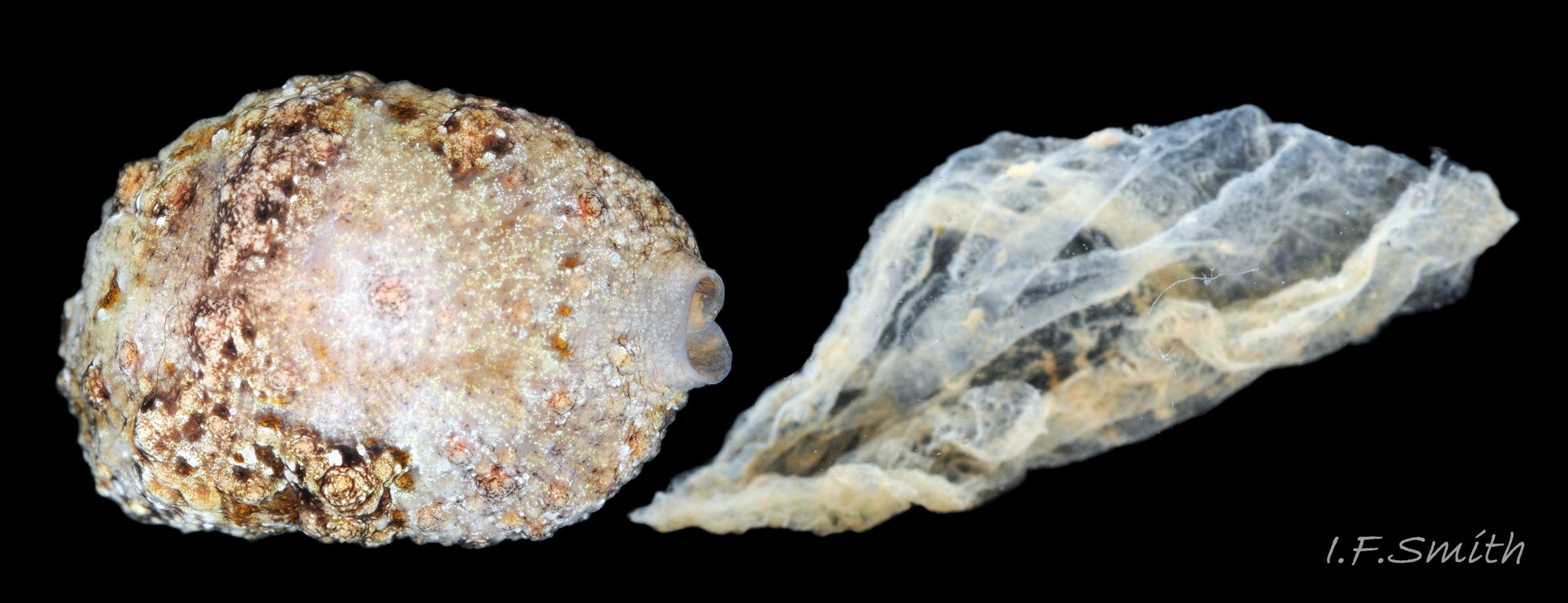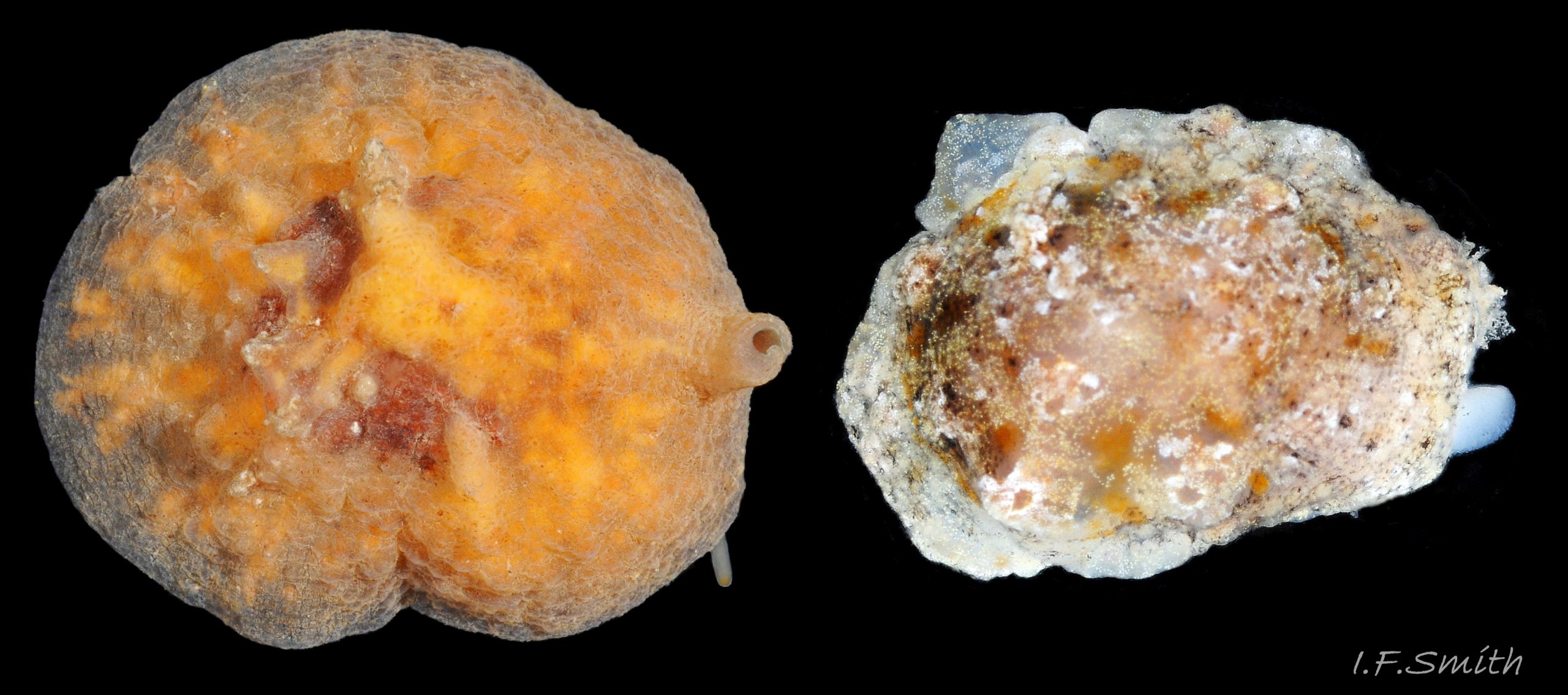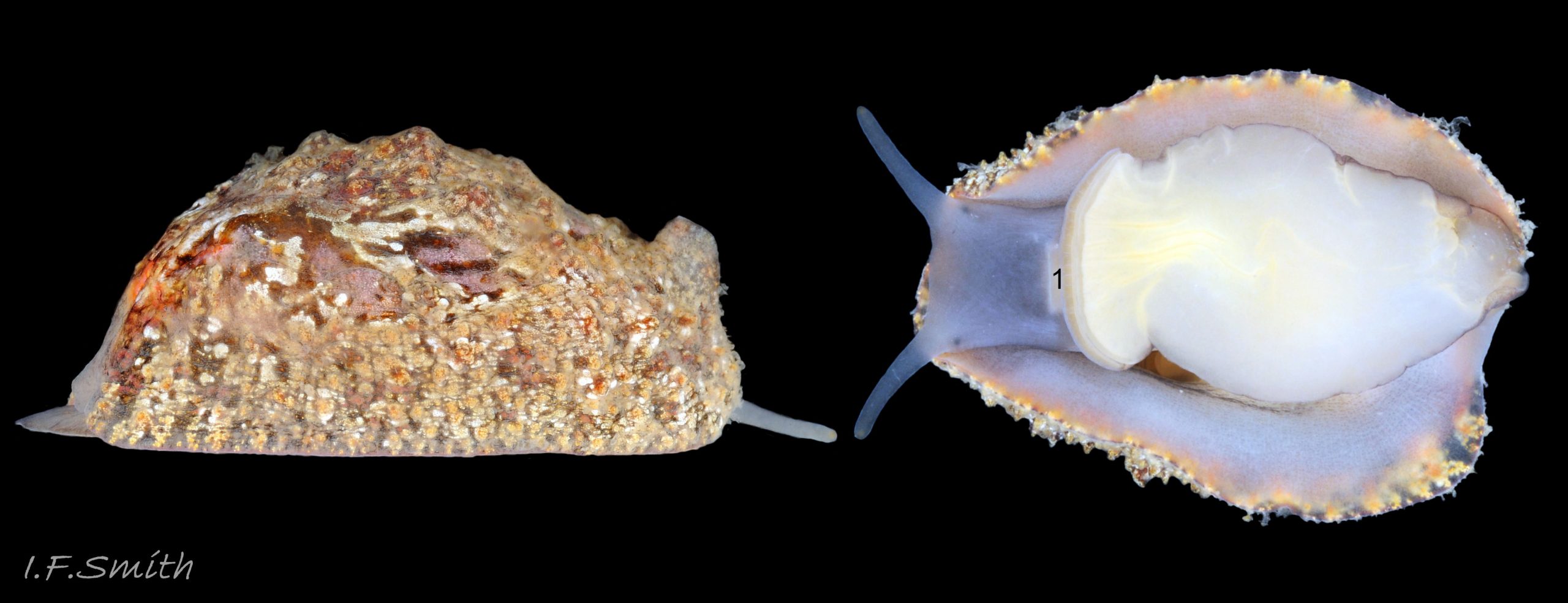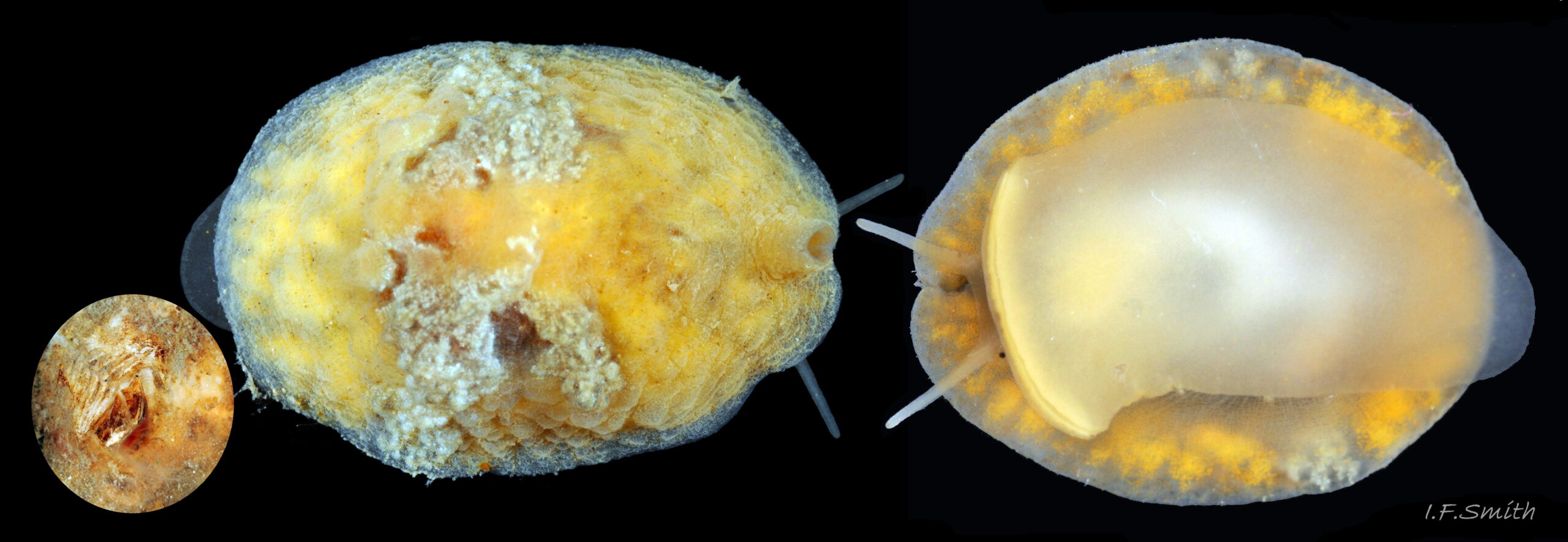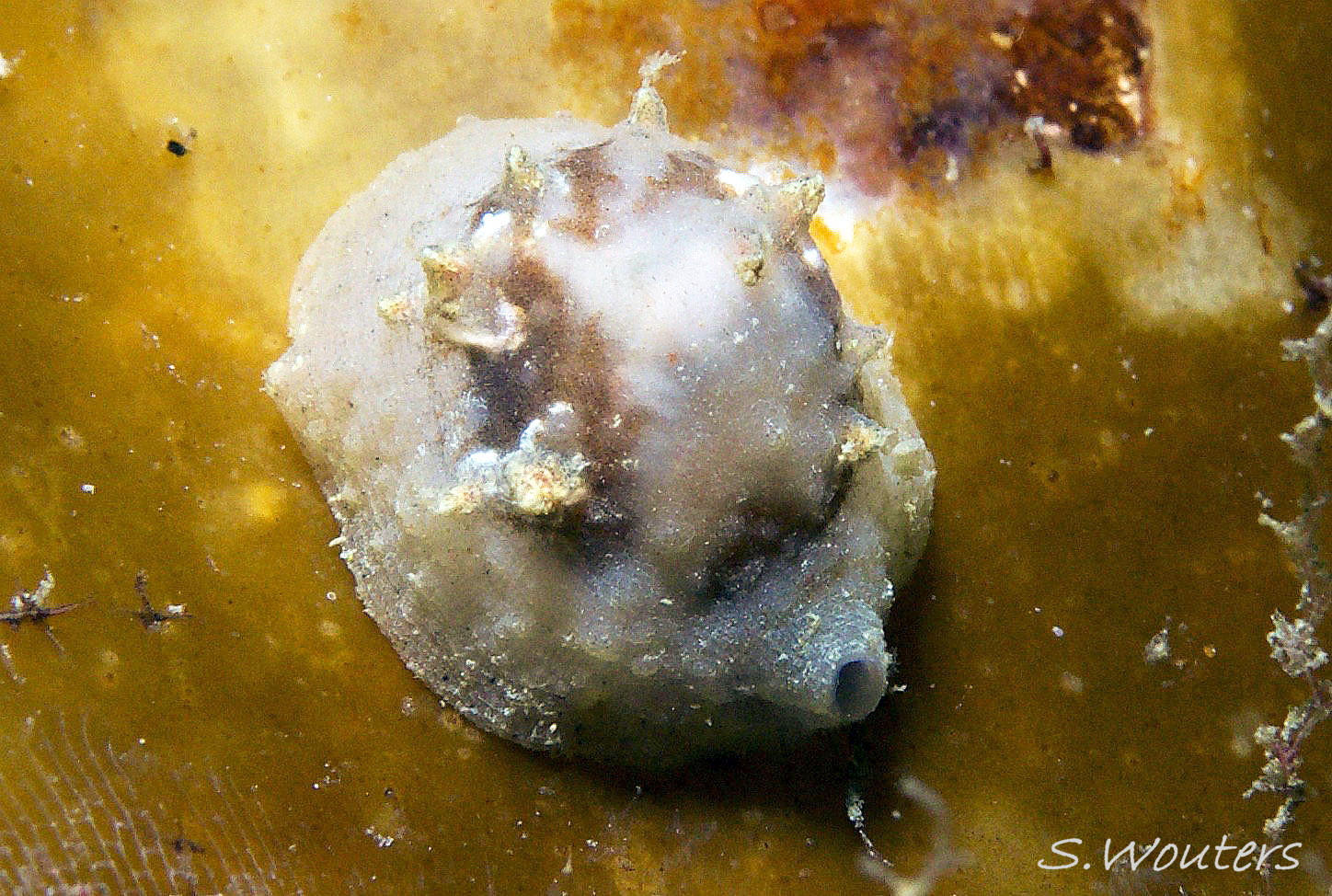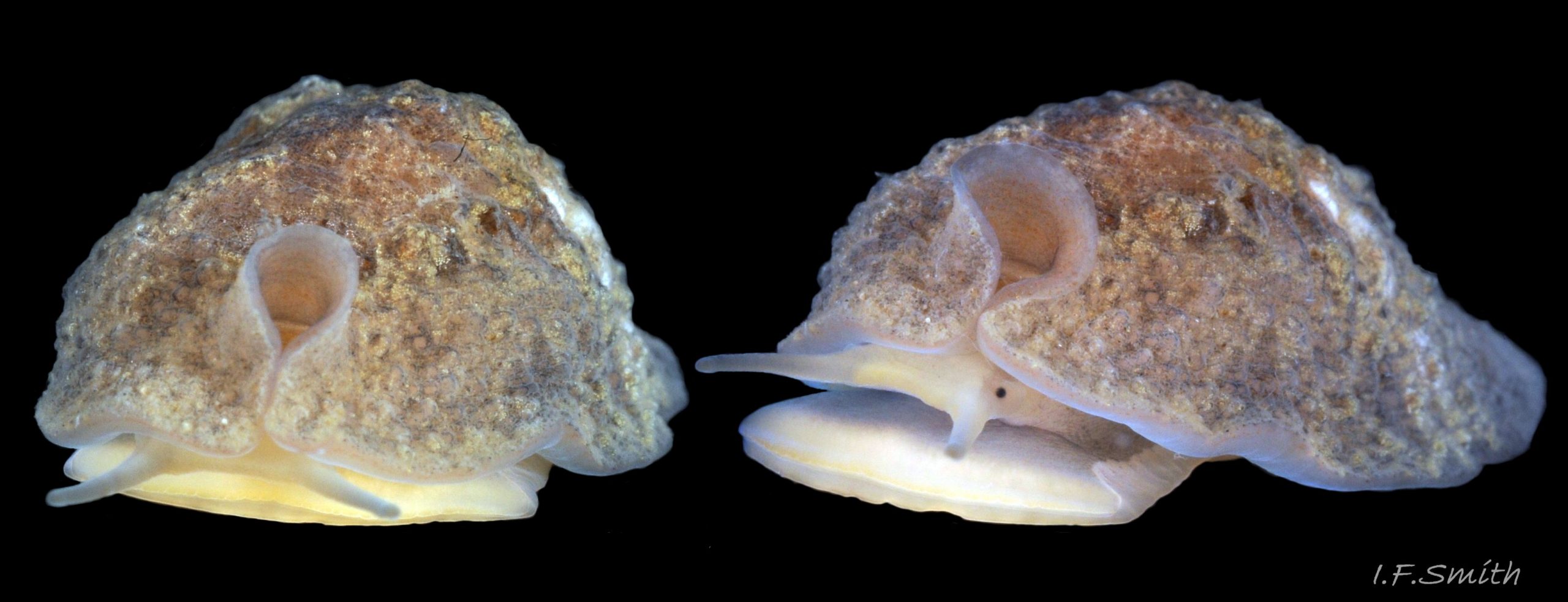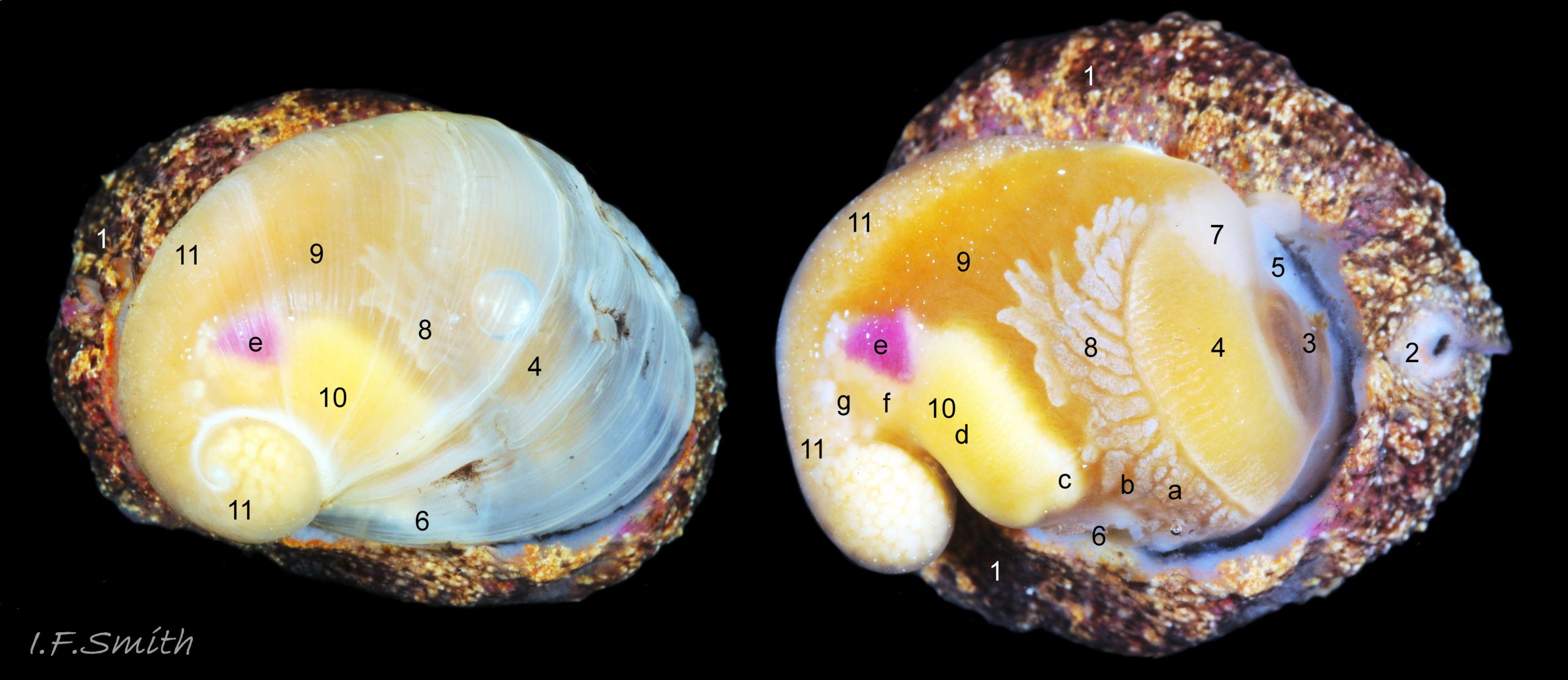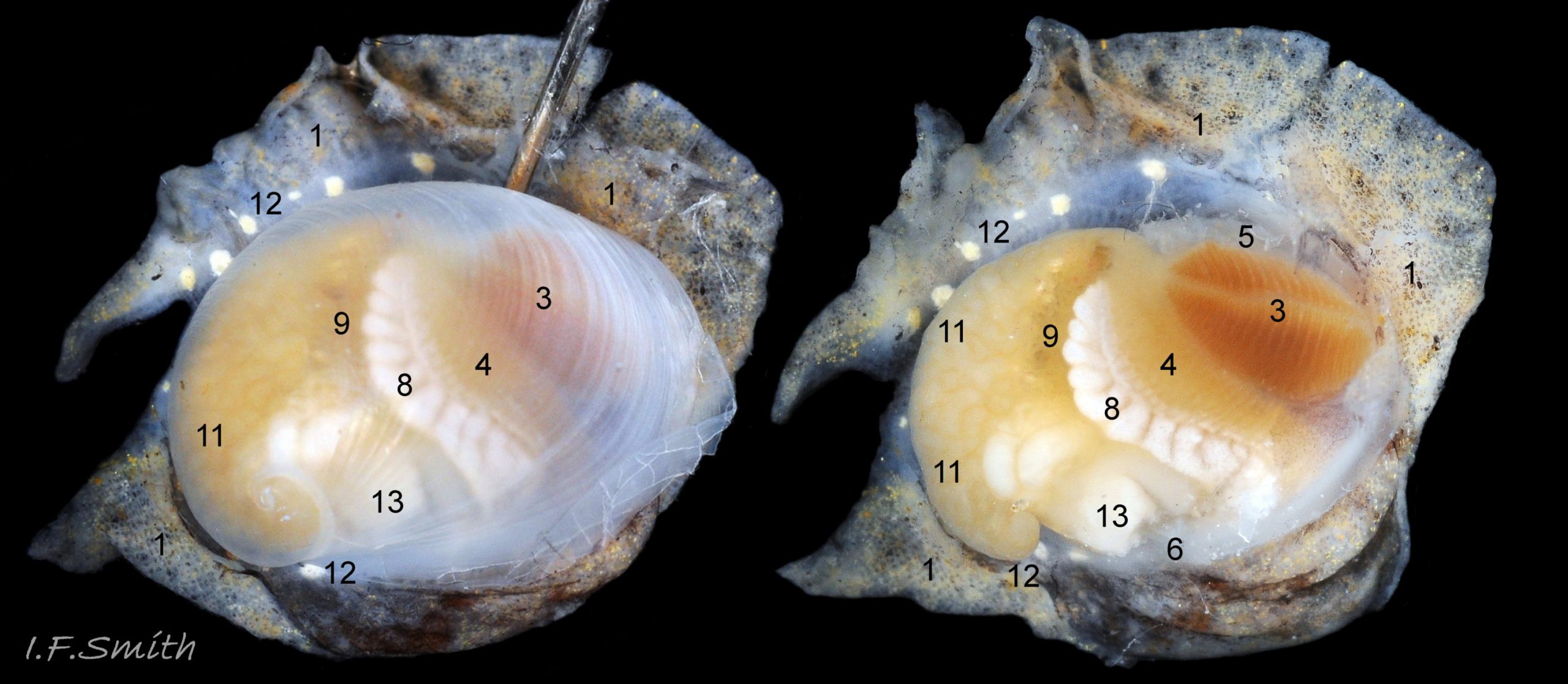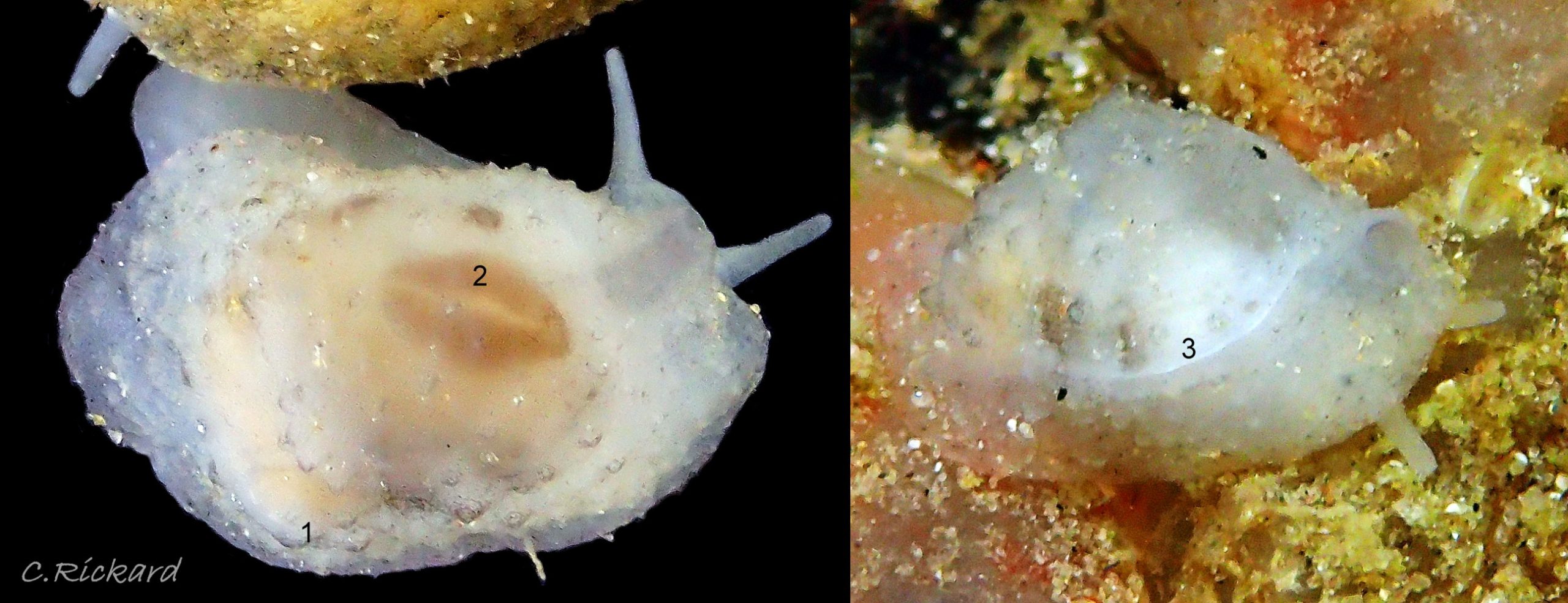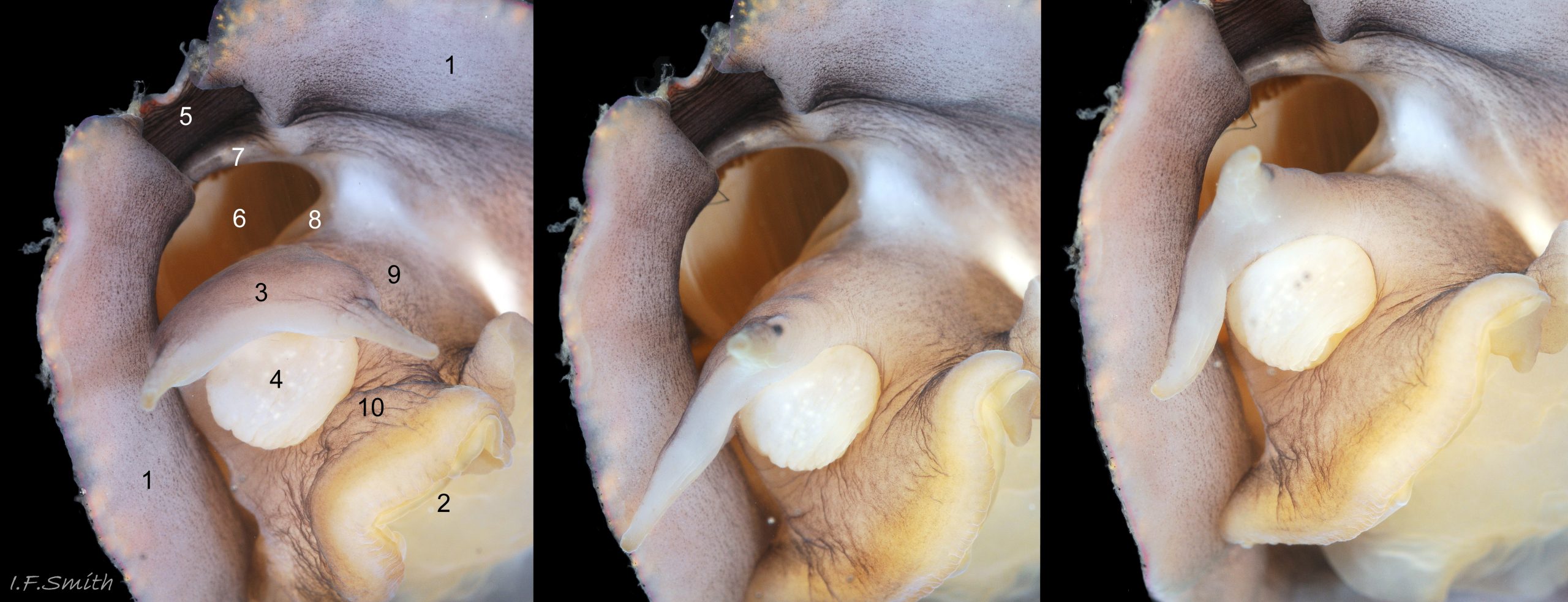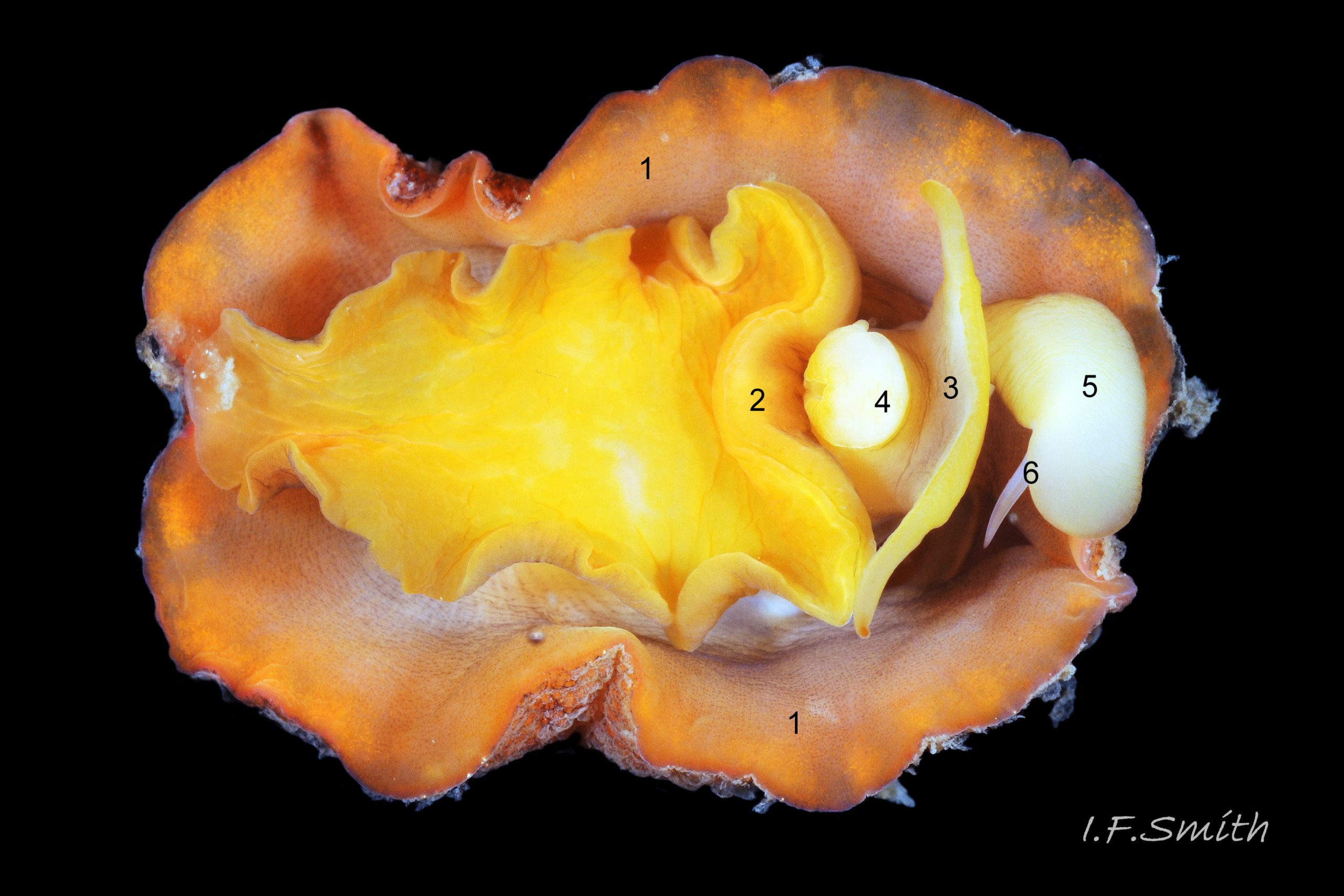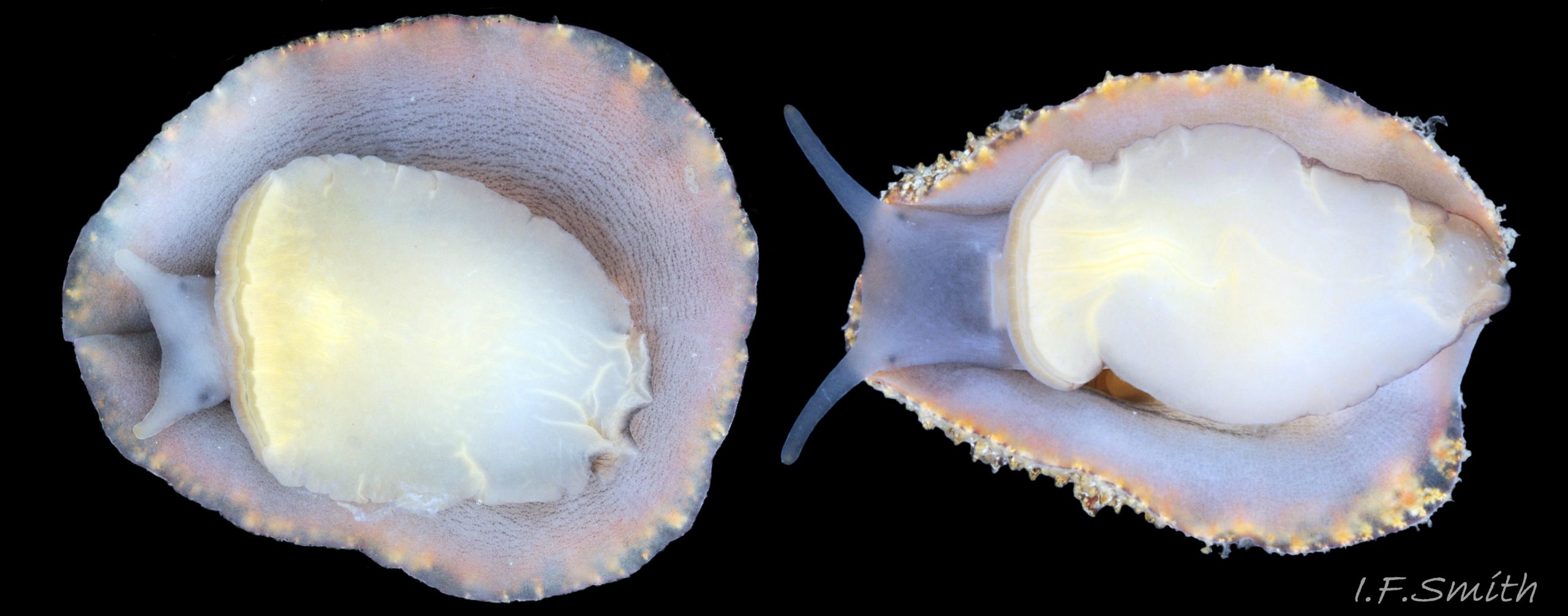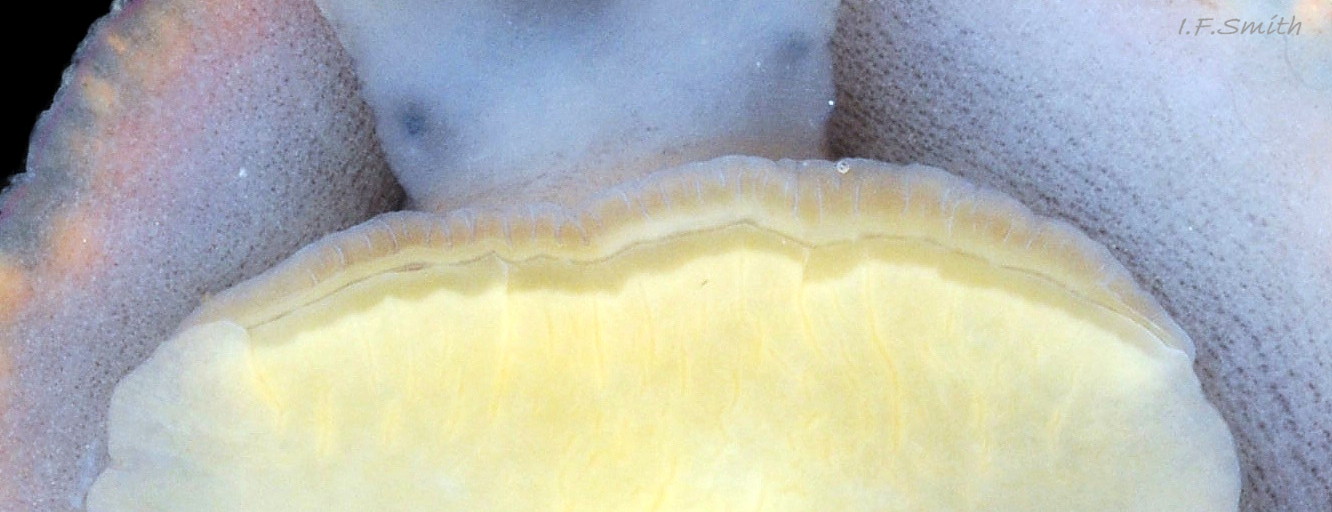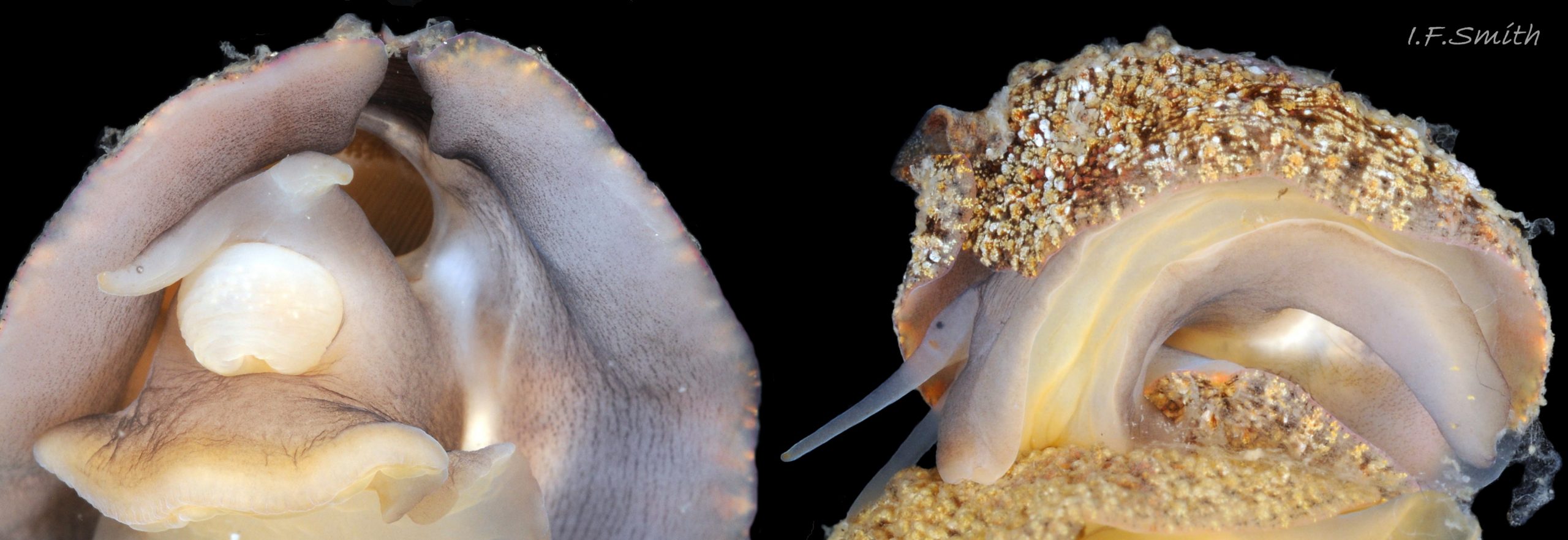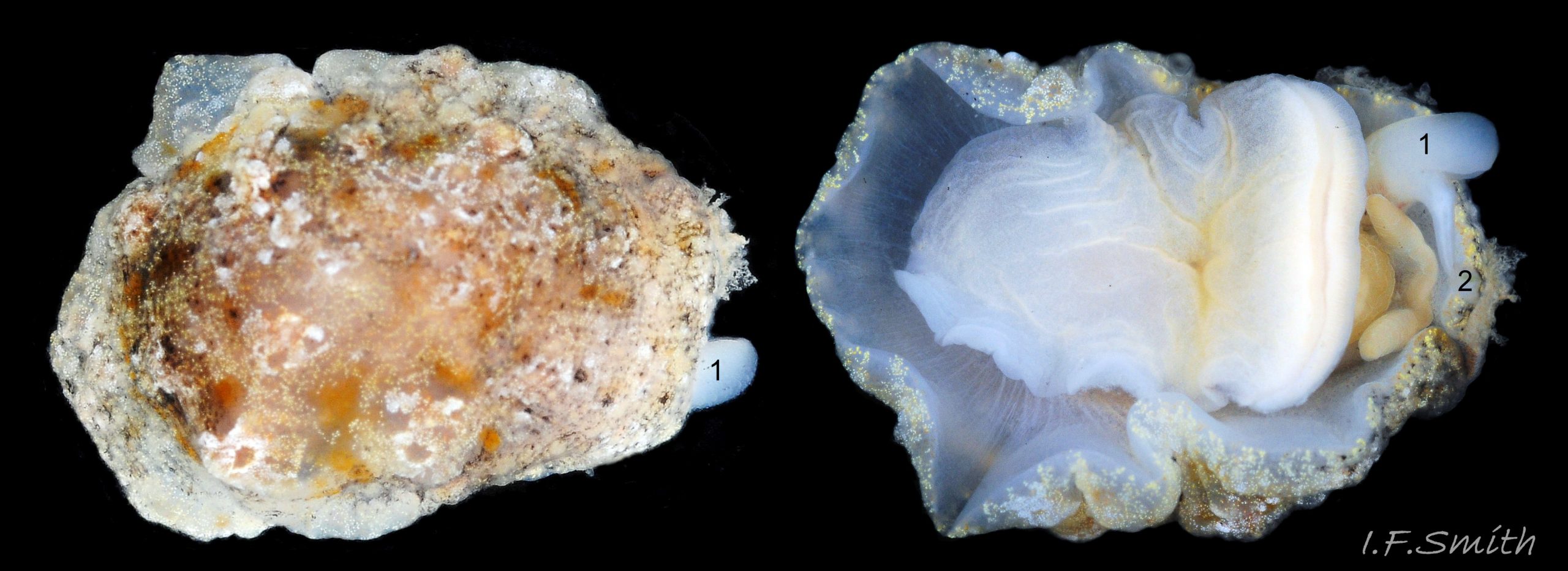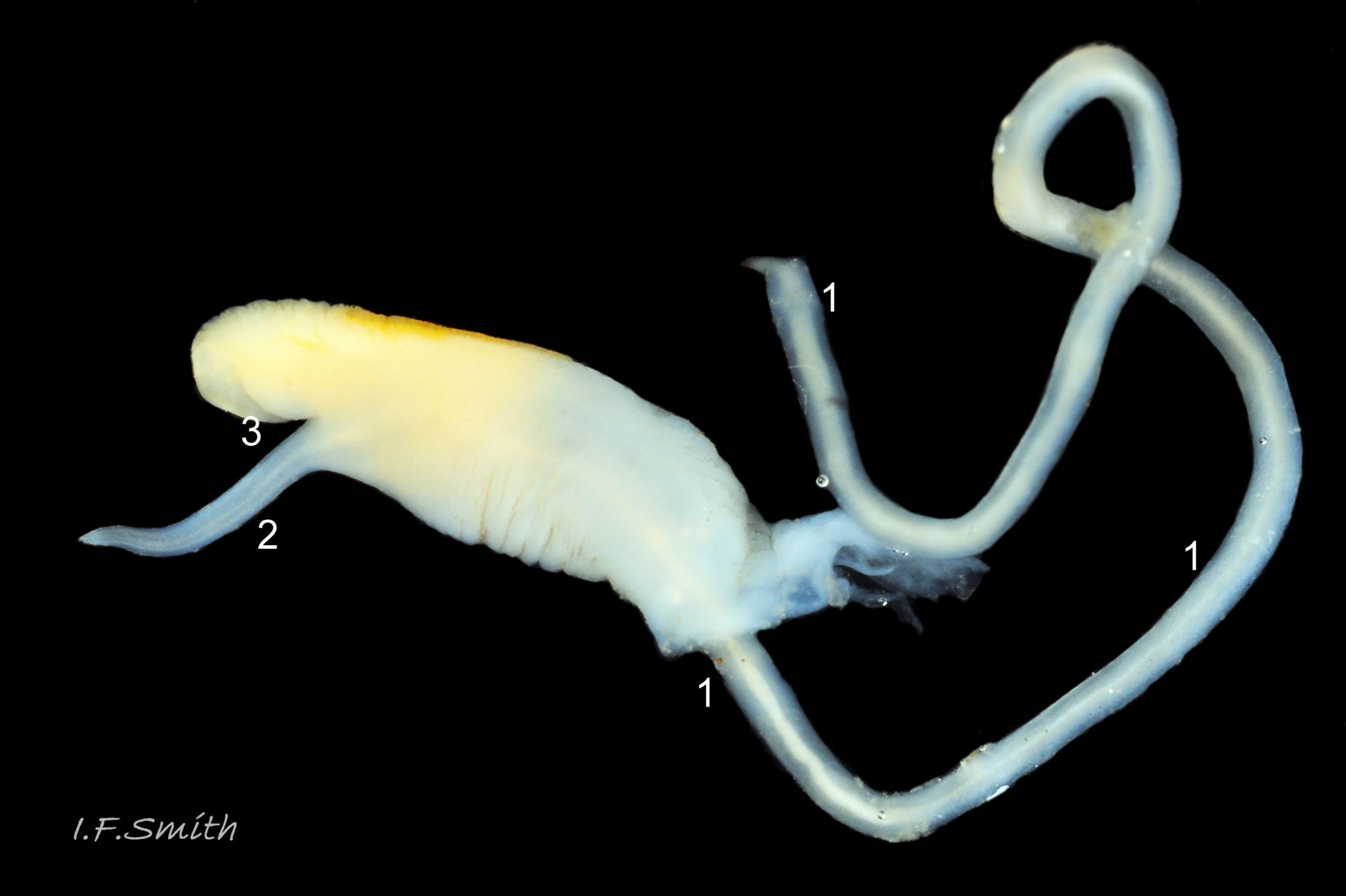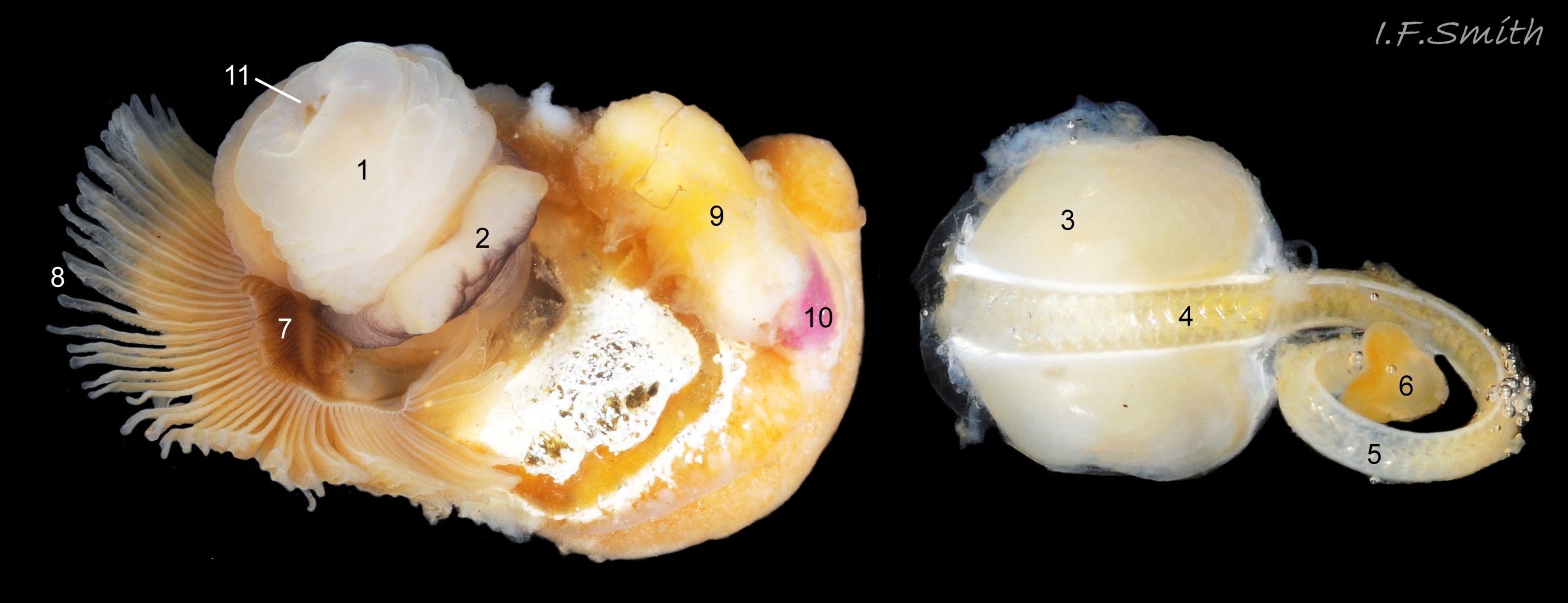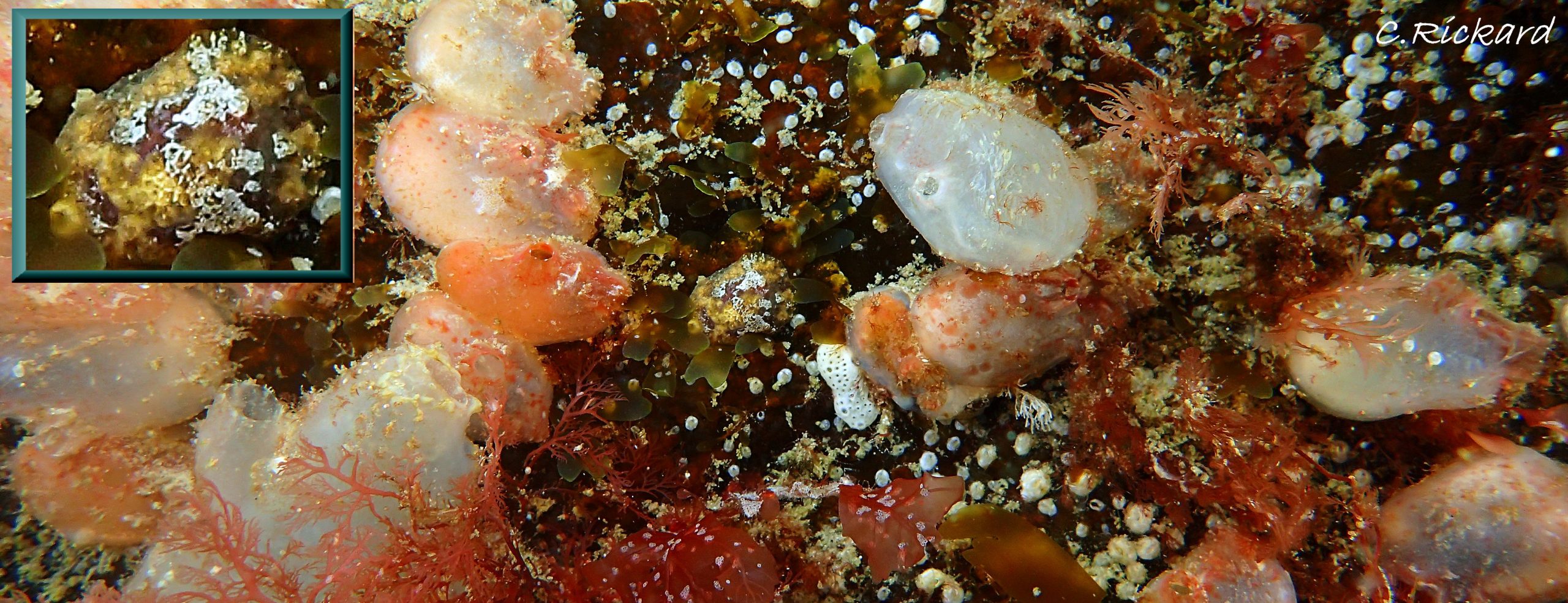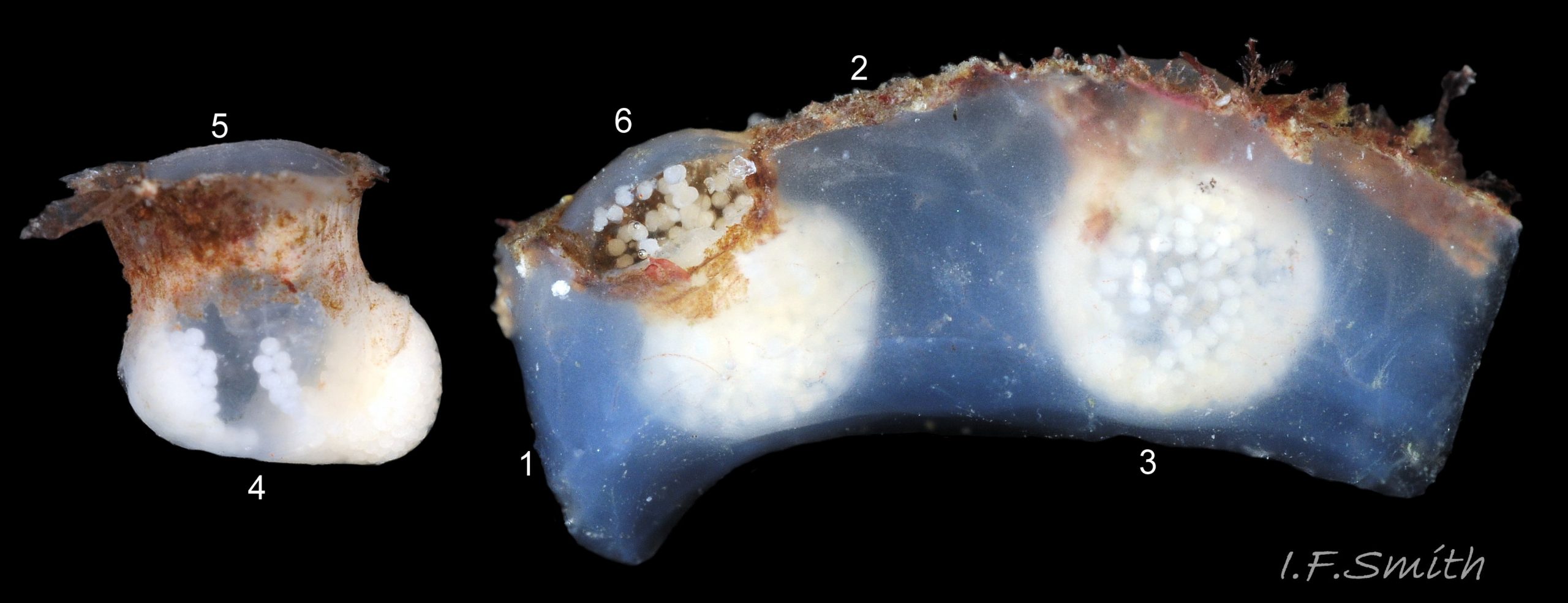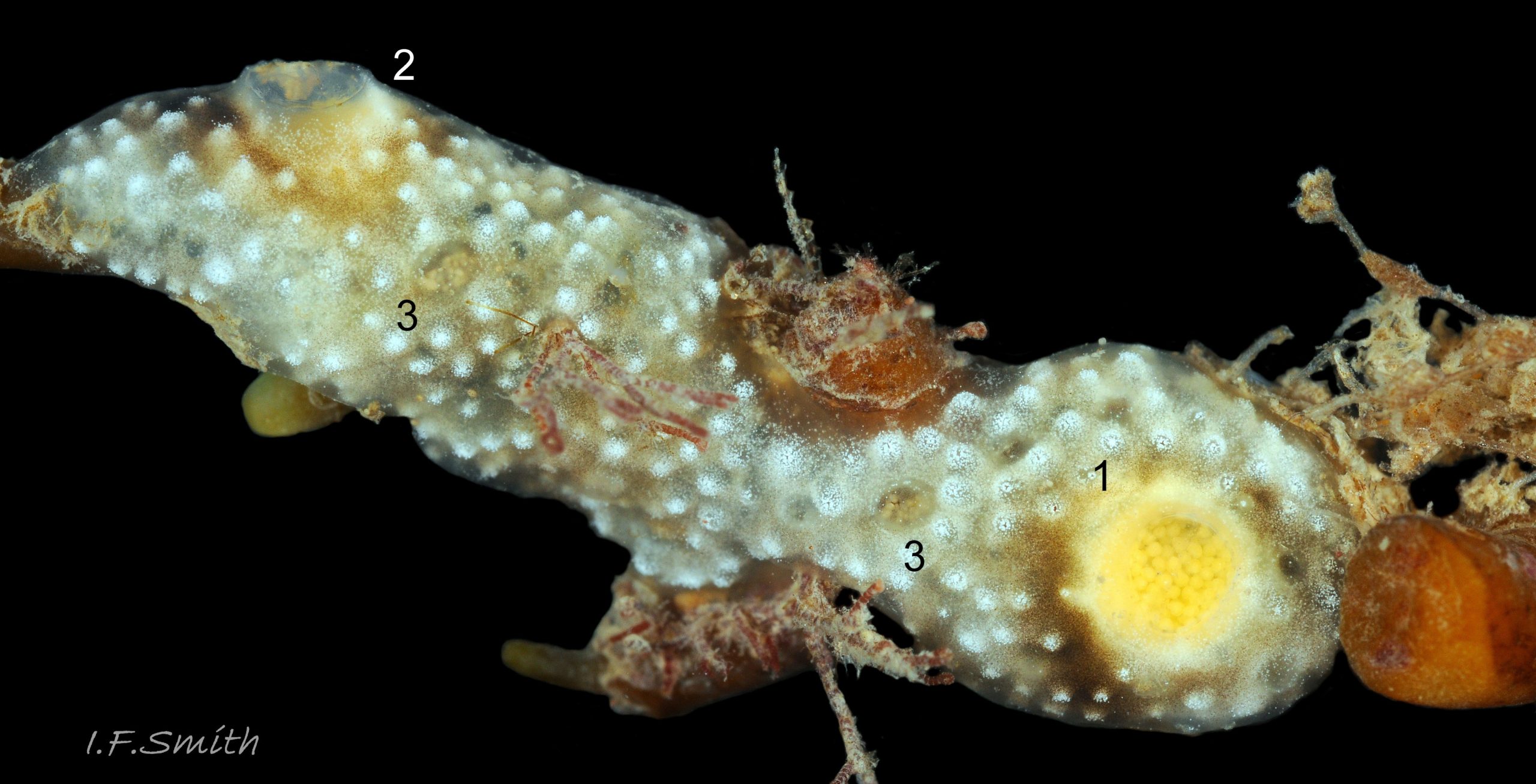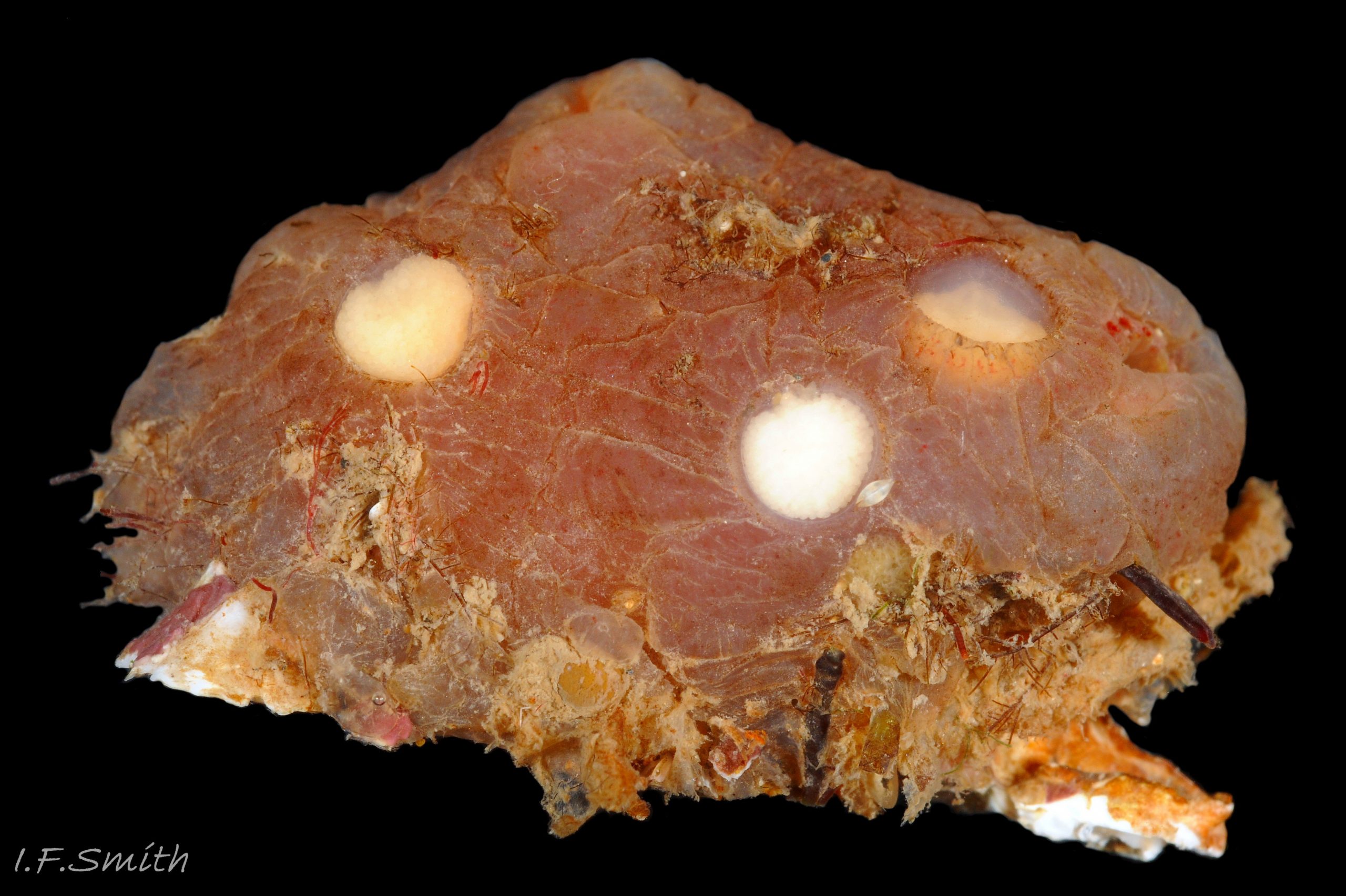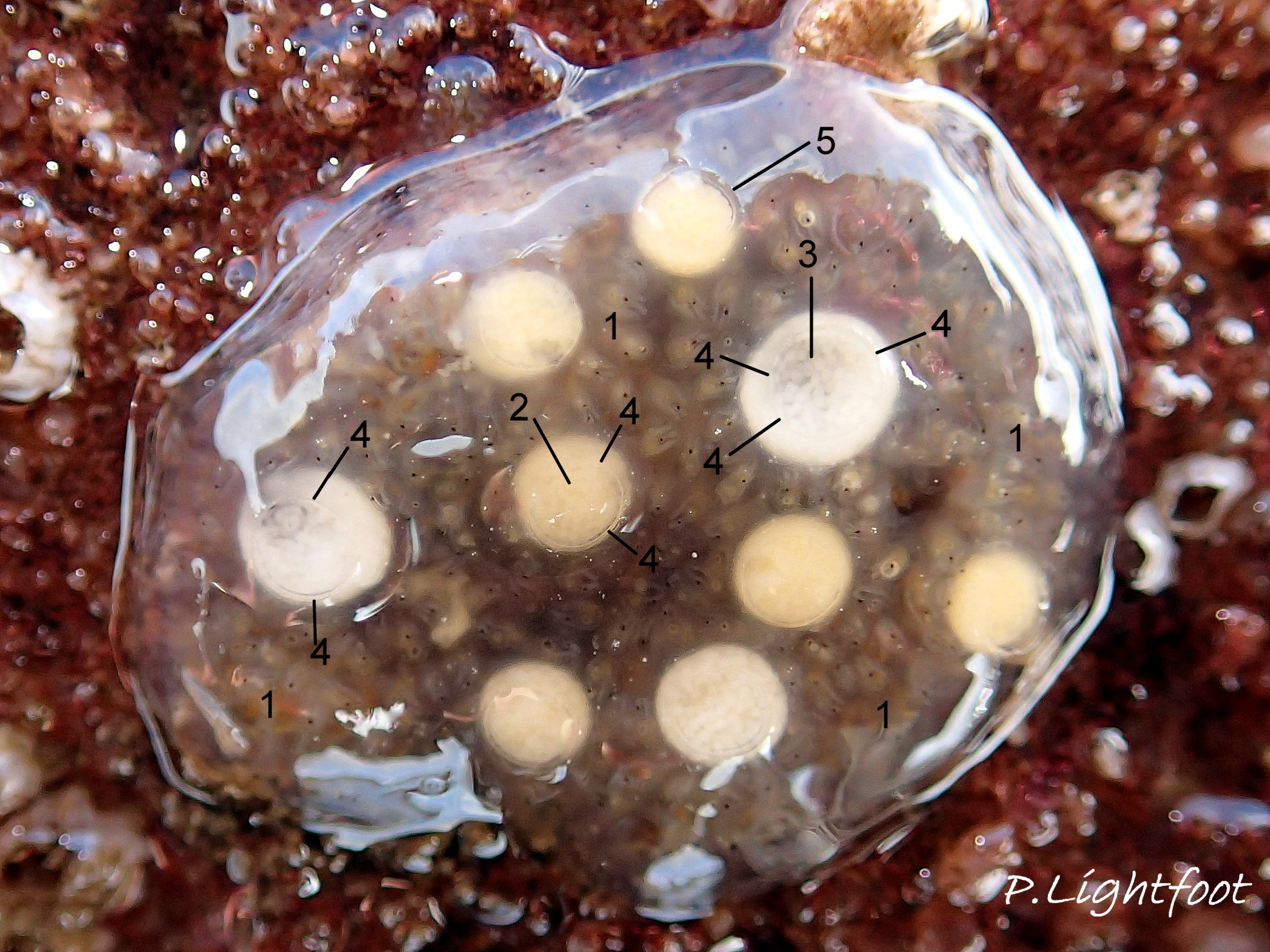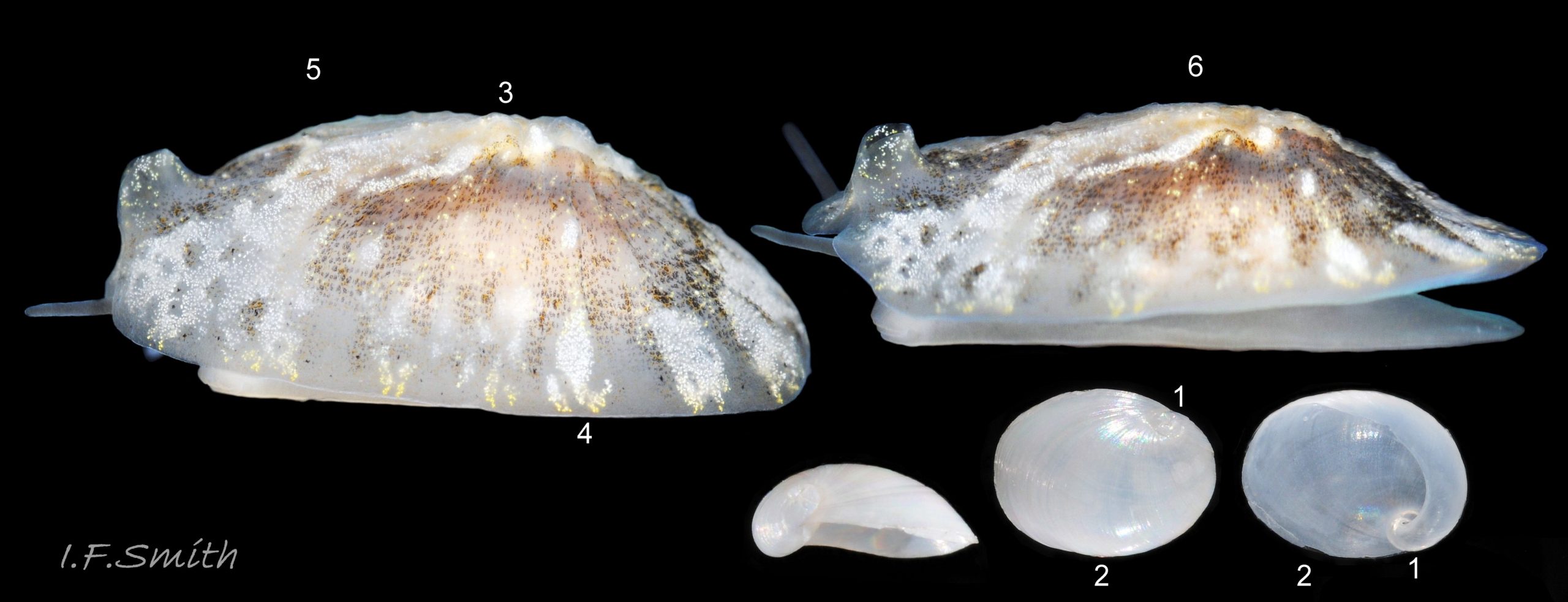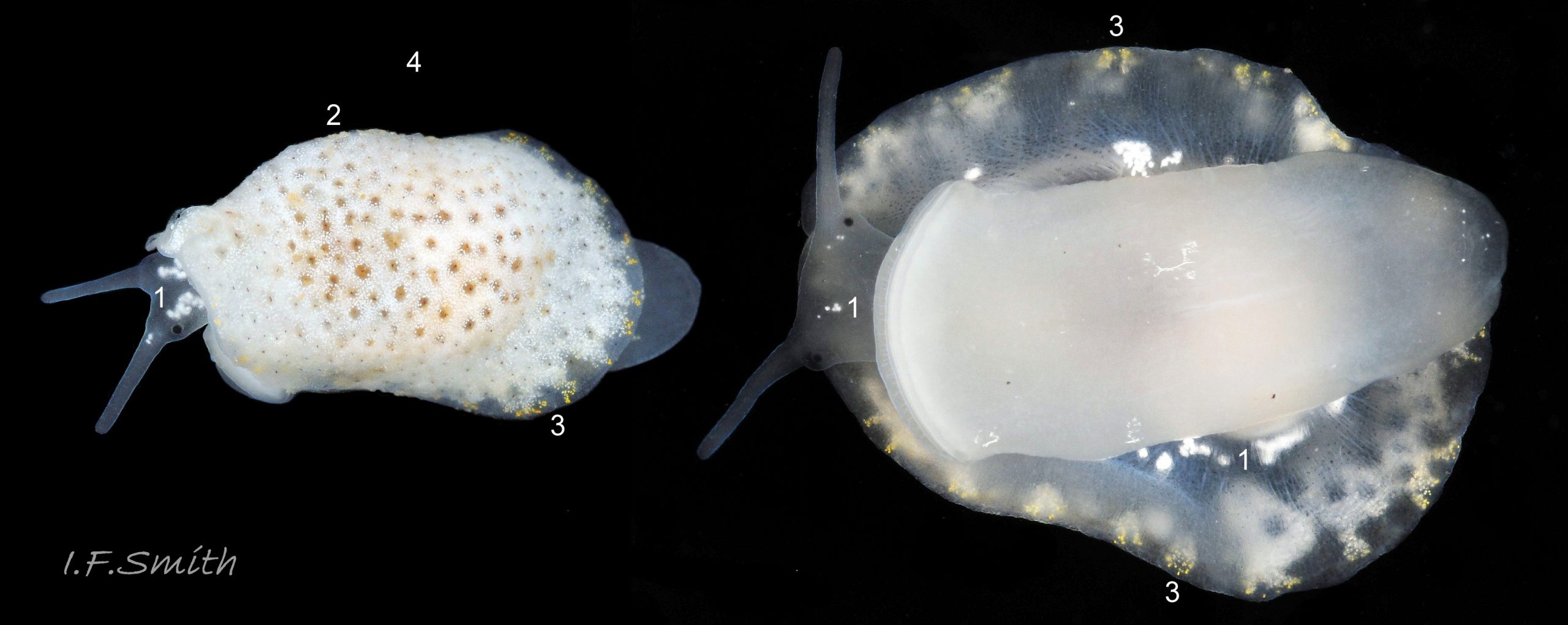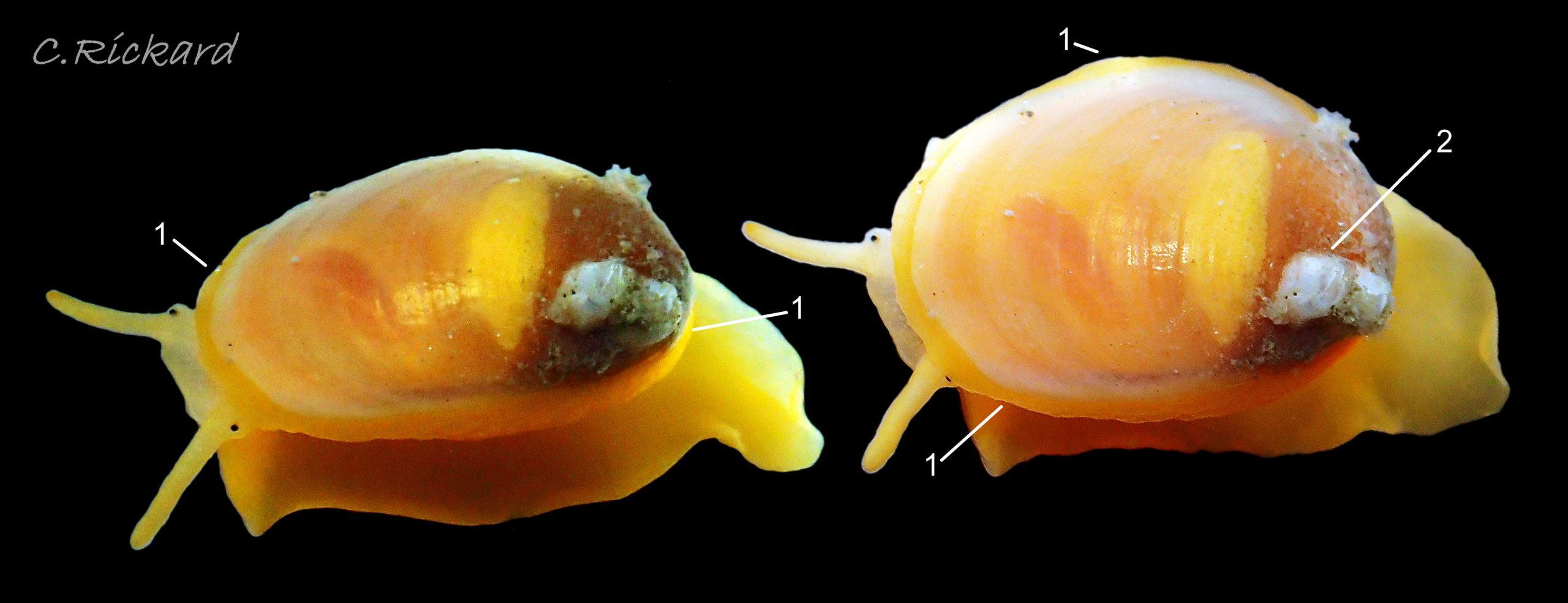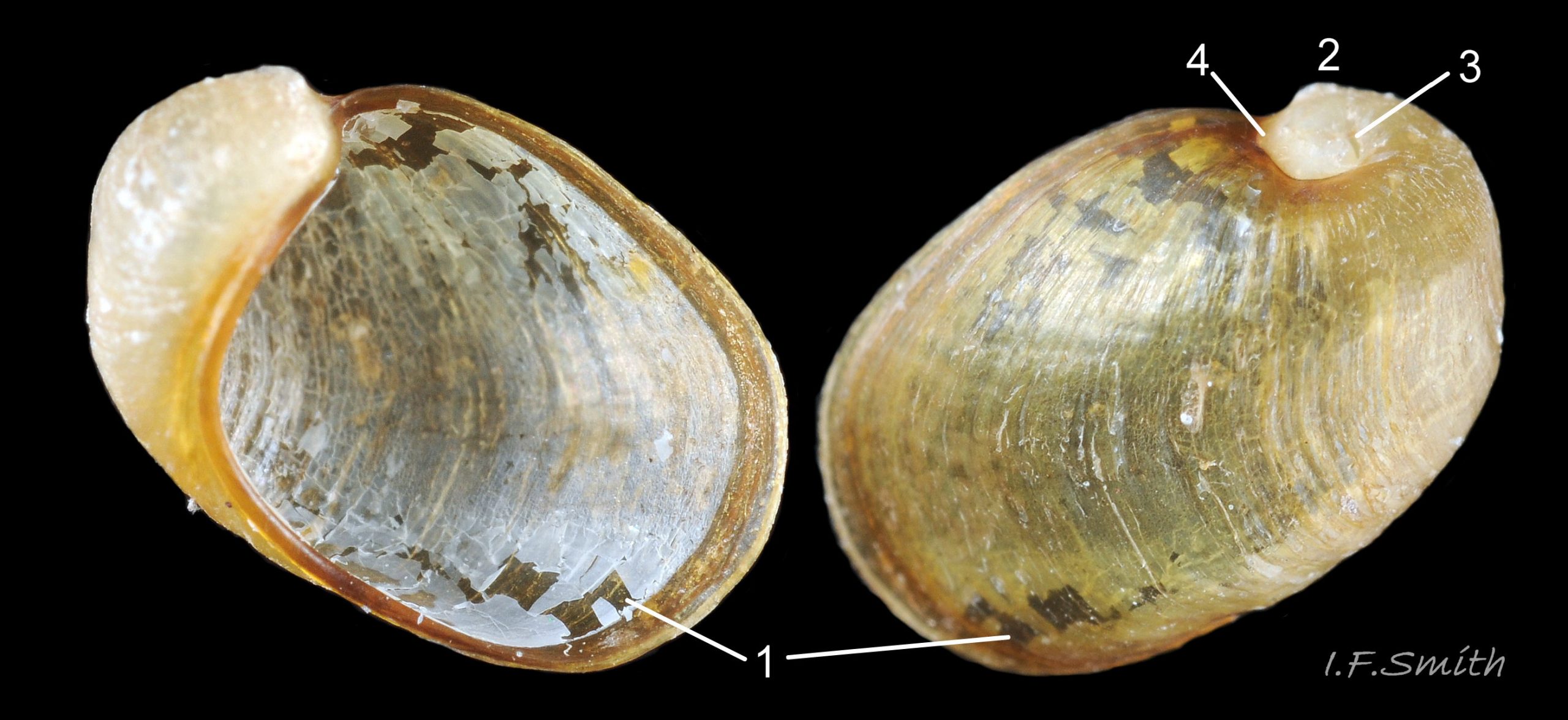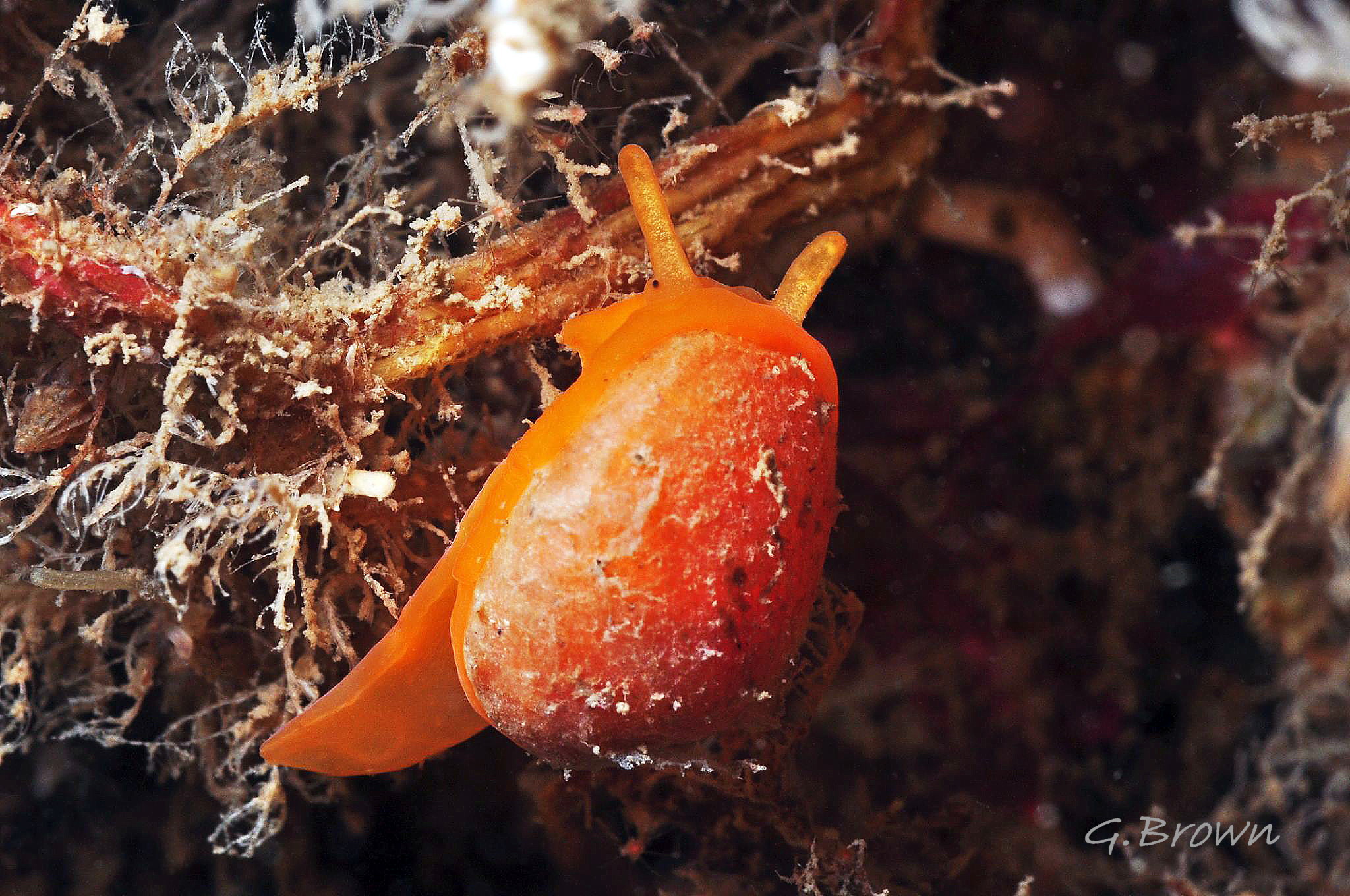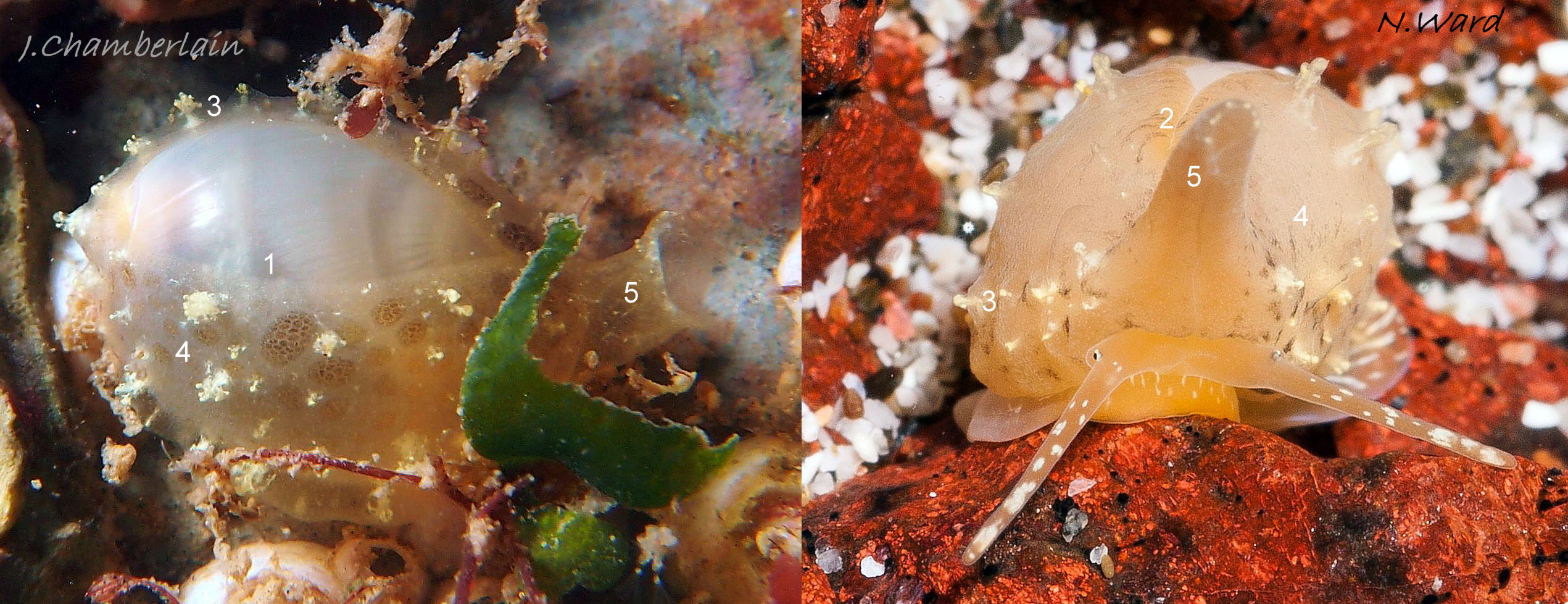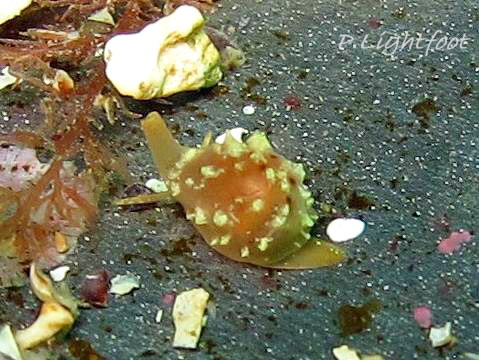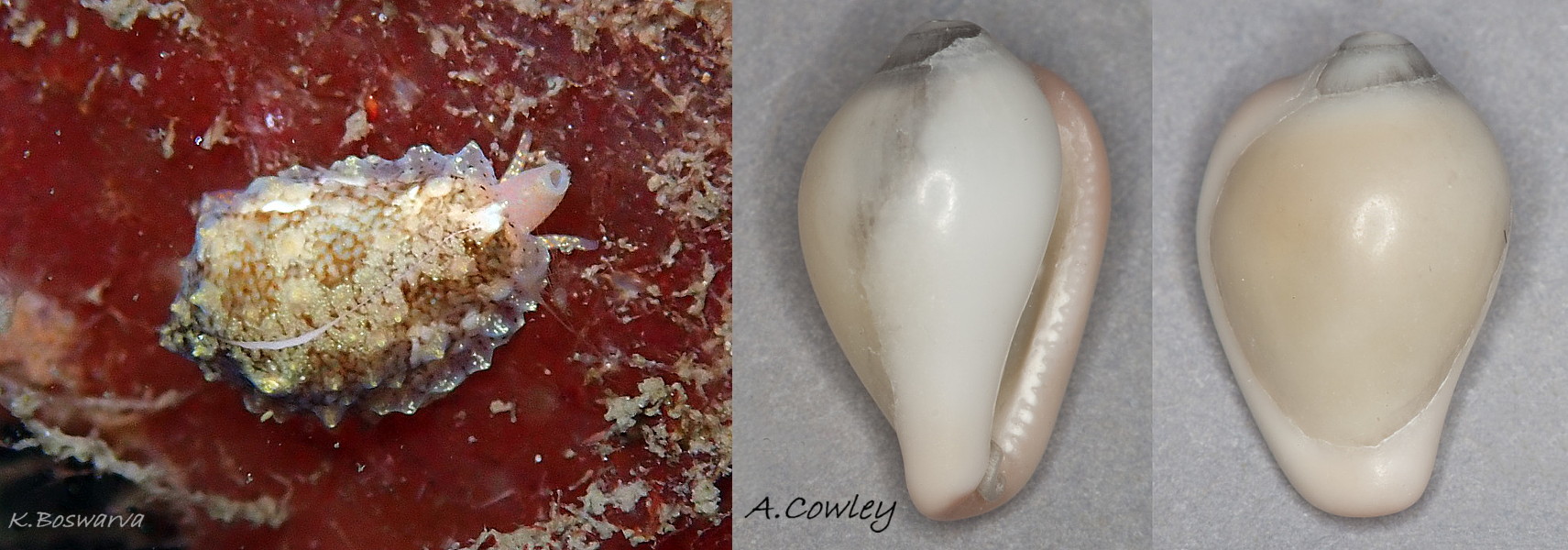Click image to enlarge with full caption. Main text below slider.
Marsenia perspicua (Linnaeus, 1758)
Synonyms: Helix perspicua Linnaeus, 1758; Lamellaria perspicua (Linnaeus, 1758).
Current taxonomy: World Register of Marine Species (WoRMS)
https://www.marinespecies.org/aphia.php?p=taxdetails&id=1505994
Vernacular: Groot glasmuitje (Dutch); kappeskael (Danish).
GLOSSARY below.
Introduction
M. perspicua is a dioecious caenogastropod, closely related to European cowries, Trivia spp. 01 Marsenia perspicua , rather than a hermaphrodite heterobranch like the majority of seaslugs. As it has an internal shell into which it cannot retreat, it qualifies as a ‘seaslug’, a non-scientific term.
Shell description
The shell height (longest dimension) of M. perspicua is up to 20 mm 02 Marsenia perspicua. It is weakly calcified, fragile and colourless semitransparent or clouded translucent 03 Marsenia perspicua, and it is permanently covered by the fused right and left mantle lobes 01 Marsenia perspicua. The periostracum is unobtrusive, transparent, very thin and slightly yellowed 04 Marsenia perspicua. The large body whorl forms over 90% of the shell. Two small, but rapidly expanding, spire whorls meet at a deep suture 03 Marsenia perspicua. The shell is approximately ear-shape with a widely-open, weak lipped aperture 05 Marsenia perspicua. The inner (columellar and parietal) lip is slightly folded back. The small spire distinctly protrudes beyond the outer (palatal) lip of the aperture in apertural and abapertural view 03 Marsenia perspicua & 05 Marsenia perspicua. There is no sculpture except growth lines and, occasionally, some very faint spiral lines 04 Marsenia perspicua. It is rarely washed up intact on the strandline. There is possible ambiguity over shell sizes in published accounts because of difficulty in measuring conventional height (apex to furthest point of aperture) of these fragile and unusually shaped shells, and perhaps identification confusion in collections of M. perspicua and Lamellaria latens shells. The longest dimension of the shell is usually half the length of the body, or slightly more. It has no operculum.
Body description
The maximum body-length is usually 20 mm (Graham, 1988); exceptionally it reaches 30 mm 06 Marsenia perspicua. The shape of an individual can be varied between a moderate 07 Marsenia perspicua or high dome (08 Marsenia perspicua) and a cone 09 Marsenia perspicua. The fused mantle lobes often have large irregular tubercles, but the surface can be almost smooth 10 Marsenia perspicua. Sometimes an outer layer of epidermis is sloughed (Bate in Forbes & Hanley 1853), revealing fresh bright colours 11 Marsenia perspicua and sometimes results in the loss of the majority of the sculpture and colour 12 Marsenia perspicua.
The colours and patterning are extremely variable. The ground colours include lilac-grey 06 Marsenia perspicua , buff 13 Marsenia perspicua, whitish 10 Marsenia perspicua, orange 08 Marsenia perspicua and grey-brown 07 Marsenia perspicua. The ventral surface of the mantle has just the ground colour with no pure white opaque marks 14 Marsenia perspicua, but translucency may reveal markings on the dorsum 15 Marsenia perspicua. The dorsal surface often has marks of white, orange, yellow, black, and/or red 08 Marsenia perspicua to 15 Marsenia perspicua which may cover almost all the ground colour and, frequently, mimic sessile animals such as ascidians 10 Marsenia perspicua, sponges 15 Marsenia perspicua or barnacles 15 Marsenia perspicua. Sometimes, mobile organisms, such as juvenile Trivia seem to be mimicked 15.1 Marsenia perspicua. Occasionally, whitish M. perspicua 10 Marsenia perspicua resemble Lamellaria latens with yellow marks near the edge of the mantle and a fine black stipple with greyish discs mimicking Tridemnum.
The anterior edge of the mantle is curved into a cylindrical siphon with a cut along its anterior face, so it can be uncurled at times 16 Marsenia perspicua. There are no gills or tentacles on the dorsal body surface. The mantle within the shell is thin, transparent and colourless so, when the shell is removed, the internal organs are clearly visible through it 17 Marsenia perspicua.
The translucent head is coloured as the ground colour of the body with no pure white, opaque marks 14 Marsenia perspicua. When not feeding, the head is flat and rectangular with long, slender, smooth cephalic tentacles on the anterior corners and no visible snout projecting between the tentacles. On the ventral face of the head there is an opening to a sac containing an inverted white proboscis, the straight, white, folded edge of which may be visible when the translucent head is well extended 14 Marsenia perspicua. When ready to feed, the proboscis is engorged and everted from the slit 18 Marsenia perspicua & 19 Marsenia perspicua. The buccal mass and radula are within the proboscis.
As well as covering the shell, the mantle lobes extend beyond it to create a peripheral cavity which covers the head and foot. Within the shell, above the head and close to the respiratory siphon there is a respiratory mantle cavity with an opening restricted by the shell rim and mantle 18 Marsenia perspicua & 20 Marsenia perspicua which contains a substantial, bright orange or brown, bipectinate osphradium and a large, pale orange or yellow, unipectinate ctenidium with very long filaments. A glimpse of the respiratory cavity and its contents may sometimes be had on a live specimen 18 Marsenia perspicua, but dissection is required for a clear view 20 Marsenia perspicua.
The foot varies in shape from almost as wide as long to moderately long and narrow (Fretter and Graham, 1981) 21 Marsenia perspicua. The broad, truncated anterior is bilaminate with the slit extending a short distance along the sides; the anterior pedal gland opens within it 22 Marsenia perspicua. The upper lip of the slit may be corrugated. The dorsal surface of the foot is a similar colour to the ventral surface of the mantle 18 Marsenia perspicua & 23 Marsenia perspicua. The sole is paler than the mantle, often whitish becoming yellowish in parts that are compressed 21 Marsenia perspicua , but on strongly coloured animals it may be a paler shade of the mantle ground colour 08 Marsenia perspicua.
Males have a large, pale penis behind the right tentacle 19 Marsenia perspicua & 24 Marsenia perspicua . The substantial genital duct runs a long circuitous route before entering the base of the penis and emerges as a flagellum about a quarter of the way from the distal end of the penis 25 Marsenia perspicua. The distal quarter of the penis has a deep groove which accommodates much of the flagellum to give it support during copulation. The flagellum tapers to a fine point from which sperm emerge.
Further detail visible with simple dissection
The fused mantle lobes can be removed from over the concealed shell of an anaesthetized, relaxed and killed specimen with a sharp scalpel run around the edge of the shell. The translucent shell will be exposed and several internal organs will be partially visible through it 17 Marsenia perspicua; occasionally, this applies to a live sloughed specimen 17.2 Marsenia perspicua.
Removal of the shell will allow the organs to be clearly seen through the thin transparent mantle 17 Marsenia perspicua. Items visible should include:
1: mantle skirt left after cutting; males will have a large penis below the skirt on the right of
the animal.
2: respiratory siphon in mantle skirt.
3: bright orange or brown, bipectinate osphradium which tests water quality of the inhalant
current and, possibly, filters out large debris before the current reaches the ctenidium.
4: large, pale orange or yellow, unipectinate ctenidium (gill) with very long filaments.
5: white, left shell-muscle.
6: white, right shell-muscle.
7: white pericardial sac containing the heart.
8: convoluted hypobranchial band which shows as a series of irregular white bands on the
mantle. It secretes mucus for trapping and cementing particulate matter from the inhalant
current before it is expelled.
9: kidney.
10: (in females) oviduct consisting of:
a: genital aperture which penis of male enters, and from which capsules, each containing
1000 to 3000 ova, emerge.
b: capsule duct leading to genital aperture.
c: white mucoid cells at anterior of capsule gland.
d: capsule gland where capsule is formed around ova.
e: bright purple-pink posterior lobe of capsule gland.
f: albumen gland which produces albuminous fluid for nutrition of ova in the egg capsule.
g: ducts at the rear of the capsule gland receive sperm from the fine tip of the flagellum of the
male’s penis.
[In this species the male’s prostate gland is a narrow, unobtrusive tube, so does not feature prominently in the position occupied by the oviduct on females.
11: ovaries (or testes in males).
12: round, white, acid producing, repugnatory glands in the mantle near the edge of the shell
Cutting the stricture at the entrance to the respiratory cavity will expose more of the ctenidium 20 Marsenia perspicua. Further cutting will release it to spread and show more detail of its lamellae 26 Marsenia perspicua.
Dissection of the proboscis (generally extruded if specimen is anaesthetised and relaxed) 26 Marsenia perspicua will expose the large whitish odontophore supporting a substantial colourless transparent radula, seen through the transparent radular sac which originates in a yellow, heart-shaped posterior end 26 Marsenia perspicua. Opening of the body of a male should expose the substantial, convoluted genital duct that enters the base of the penis and emerges as a flagellum about a quarter of the way from the distal end 25 Marsenia perspicua.
Key identification features
Marsenia perspicua
1: maximum length when live usually 23 mm, occasionally 30 mm 06 Marsenia perspicua.
2: mantle lobes fused; no dorsal break or joint visible.
3: dorsal surface varies from strongly tuberculated 07 Marsenia perspicua to almost smooth 10 Marsenia perspicua.
4: dorsal surface has wide range of colours and patterns 13 Marsenia perspicua, including ones similar to
Lamellaria latens 10 Marsenia perspicua.
5: shape of live animal is moderate to high dome 07 Marsenia perspicua or conical 09 Marsenia perspicua.
6: ventral surface of mantle lobes includes pale shades of lilac-grey, buff, off-white, orange
and grey-brown, not with pure white, opaque marks on ventral surface of mantle lobes
or head 21 Marsenia perspicua . Occasionally translucent enough to see from underside the overlying
dorsal pattern 15 Marsenia perspicua.
7: short spire protrudes beyond outer lip of aperture when ear-shaped shell is viewed in
plan 03 Marsenia perspicua & 05 Marsenia perspicua.
Similar species
Lamellaria latens (O. F. Müller, 1776)
Diagnostic features 6 & 7 of L. latens are not found on M. perspicua. Other features are usually found on L. latens, but sometimes also on the widely variable M. perspicua
1: Maximum length when live 11 mm (6 to 8 mm frequent size).
!! Young M. perspicua can be under 11 mm length.
2: mantle lobes fused; no dorsal break or joint visible 32 Marsenia perspicua. !! also M. perspicua .
3: Dorsal surface smooth to weakly tuberculated 31 Marsenia perspicua. !! Some M. perspicua can be also.
4: Dorsal colours mainly whitish or sandy, often with yellow flecks near mantle edge and fine black dots 31 Marsenia perspicua & 32 Marsenia perspicua. !! Some M. perspicua have these markings 10 Marsenia perspicua.
5: Individuals can vary their shape between a shallow bowl, inverted sauce 31 Marsenia perspicua and almost flat. !! M. perspicua though usually higher, can lower itself to a shallow bowl.
6: A few opaque bright white marks on translucent whitish head and/or semitransparent underside of mantle-lobes 32 Marsenia perspicua. Often dorsal markings are visible through the mantle lobes from below.
7: Spire of shell does not protrude beyond outer lip of aperture so shell outline is a smooth oval when viewed in plan 31 Marsenia perspicua.
Velutina plicatilis (O. F. Müller, 1776)
1: maximum length when live c.18 mm (excluding protruding foot and tentacles).
2: thick unfused mantle lobes can overlap a short way onto exterior of shell, but not
sufficiently to cover it all 33 Marsenia perspicua.
3: very weakly calcified, amber-brown shell consists mainly of periostracum 34 Marsenia perspicua which,
when live, forms a velvety surface often mistaken for the mantle of Marsenia or a dorid
seaslug 35 Marsenia perspicua.
4: body and extended mantle lobes orange or yellow; (sometimes white, Graham, 1988).
Shell is semi-transparent showing yellow, orange and brown viscera 33 Marsenia perspicua .
5: active animal is egg-shape with a large flat foot, and tentacles on a snoutless head, but no
external gills or siphon 35 Marsenia perspicua.
7: shell has short spire which barely protrudes from the outline of the shell, and the apex is
recessed below the previous whorl. Sutures, when not concealed by periostracum are
deeper than on M. perspicua 34 Marsenia perspicua.
Trivia monacha (da Costa 1778)& Trivia arctica (Pulteney, 1779) juveniles.
1: maximum length when live 13 mm (excluding protruding foot and tentacles).
2: mantle lobes not fused; often withdrawn to expose juvenile white shell. If fully expanded, a
dorsal break line is present 36 Marsenia perspicua , but not always visible in photographs.
3: dorsal surface smooth or with papillae 36 Marsenia perspicua & 37 Marsenia perspicua.
4: mantle dorsally whitish or yellowish-white; developing dark bands and/or marks as it
matures 36 Marsenia perspicua .
5: live animal spheroid.
7: juvenile shell is coiled and does not expose majority of interior.
Erato voluta (Montagu, 1803) 38 Marsenia perspicua.
Strong shell, height 10 mm, retains exposed spire throughout life.
Stout inhalant siphon.
White spots on tentacles.
Two sides of dark, papillate mantle meet at dorsal median line, small gap shows white shell.
Habits and ecology
M. perspicua lives from LWS to 1200 m depth (Fretter & Graham, 1981) on or under stones and rock ledges, in rock pools and in Laminaria holdfasts near its compound or unitary ascidian prey, including Botryllus, Polyclinum, Leptoclinum and Trididemnum.
To feed the stout proboscis is everted 18 Marsenia perspicua and its mouth applied to the ascidian for the radula to cut out pieces of test. Faeces are ovoid pellets.
For defence against predators, M. perspicua relies on its cryptic colouring which can resemble its ascidian prey 10 Marsenia perspicua or other sessile organisms in its haunts, such as encrusting red algae, barnacles 26.1 Marsenia perspicua and sponges 15 Marsenia perspicua , and on the ability of the mantle to secrete acid, highly distasteful to potential predators, when irritated 17.1 Marsenia perspicua. The acid secreting glands are located near the edge of the shell where they would discourage invasion of the viscera contained within it.
Respiratory water enters the mantle cavity through an anterior siphon formed by a curling of the mantle. It passes through the large bipectinate osphradium which tests the water quality and may sieve out large detritus particles before the water reaches the large unipectinate ctenidium. The osphradium and ctenidium are in a small respiratory mantle cavity with a constricted opening 18 Marsenia perspicua & 20 Marsenia perspicua.
Reproduction is in all months, with a maximum in spring and summer. The male passes its penis through the pallial oviduct 17 Marsenia perspicua so that the slender distal flagellum 25 Marsenia perspicua can insert sperm into ducts at the posterior of the oviduct. Spherical capsules with a short neck 27 Marsenia perspicua are formed in the capsule gland of the oviduct and each filled with up to 3000 ova which have been fertilized with sperm stored in the ducts. The capsule receives albumen for nutrition of the ova from the adjacent albumen gland. The female bites a circular hole in the test of one of the compound or unitary ascidian prey species. Fretter & Graham (1962 & 1994) state, ‘Velutina velutina favours the large solitary forms – – – while Lamellaria [ incl. Marsenia] eat compound ascidians’, but both sorts are used for insertion of egg capsules by M. perspicua 27 Marsenia perspicua, 28 Marsenia perspicua, 29 Marsenia perspicua & 30 Marsenia perspicua. When a filled capsule emerges from the oviduct it is inserted into the hole up to its neck by pressure of the foot, there being no specialised ventral pedal gland to aid this like that on closely related Trivia species. The neck with adhering ascidian is raised into a pronounced rim 28 Marsenia perspicua. When in encrusting compound ascidian with insufficient depth to accommodate the height of the capsule, the base of the capsule may be flattened to fit 27 Marsenia perspicua . On unitary ascidians with thicker tests, the only part of the capsule to protrude above the ascidian surface is the low dome of the translucent cap sealing the mouth and a slight rim 27 Marsenia perspicua . The capsules are translucent to semi-transparent, so the ova are often visible within. At room temperature, the ova hatch after about three weeks and, when covered in water, echinospira larvae are released from the capsule to drift in the water column. Initially, the larva has a velum of two lobes for maintaining position in the water column and capturing food. As the larva grows, each lobe subdivides so the velum becomes four-lobed and then six-lobed before the larva settles on the sea floor and metamorphoses into the adult form.
The anterior pedal gland within the widely bilaminate foot anterior 22 Marsenia perspicua produces mucus to aid locomotion; there is no ventral pedal gland. As there is no central longitudinal groove on the sole, locomotor waves are probably monotaxic.
Distribution and status
M. perspicua is found from Iceland and the Lofoten Islands in northern Norway to the Mediterranean and Azores. GBIF map https://www.gbif.org/species/5192990 shows a more widespread distribution, but caution is needed as differentiating species of Marsenia is difficult; more species may be involved. It is widespread round Britain and Ireland where hard substrate and ascidians occur. It is scarce or absent from the north-eastern Irish Sea and from Flamborough Head to Kent. U.K. interactive map NBN https://records.nbnatlas.org/occurrences/search?q=lsid:NBNSYS0000175990#tab_mapView
Acknowledgements
For specimens and/or use of photographs I gratefully thank Karen Boswarva, George Brown, Jon Chamberlain, Paula Lightfoot, David McKay, Chris Rickard, Simon Taylor, Neil Ward and Steven Wouters.
References and links
Forbes, E. & Hanley S. 1849-53. A history of the British mollusca and their shells. vol. 3 (1853) 355-359, London, van Voorst. . https://archive.org/stream/ahistorybritish05forbgoog#page/n366/mode/2up/search/Lamellaria
Fretter, V. 1946. The genital ducts of Theodoxus, Lamellaria and Trivia, and a discussion on their evolution in the prosobranchs. ;26(3): 312-351. J. mar. biol. Ass. U.K. http://plymsea.ac.uk/view/journals/Journal_of_the_Marine_Biological_Association_of_the_United_Kingdom.html#group_F (Scroll down to Fretter, V. 1946).
Fretter, V. and Graham, A. 1962. British prosobranch molluscs: their functional anatomy and ecology. London, Ray Society. (Has index of species.)
Fretter, V. and Graham, A. 1981. The prosobranch molluscs of Britain and Denmark. Part 6 – Cerithiacea, Strombacea, Hipponicacea, Calyptraeacea, Lamellariacea, Cypraeacea, Naticacea, Tonnacea, Heteropoda. J. Moll. Stud. Suppl. 9: 285-363.
Fretter, V. and Graham, A. 1994. British prosobranch molluscs: their functional anatomy and ecology. Revised edition. London, Ray Society. (Much new material but lacks index of species.)
Graham, A. 1988. Molluscs: prosobranch and pyramidellid gastropods. Synopses of the British Fauna (New Series) no.2 (Second edition). Leiden, E.J.Brill/Dr. W. Backhuys. pp.662.
Høisæter, T. 2009. Distribution of marine, benthic, shell bearing gastropods along the Norwegian coast. Fauna norvegica 28: 5-106. http://www.ntnu.no/ojs/index.php/fauna_norvegica/article/view/563
Jeffreys, J.G. 1862-69. British conchology. vol. 4 (1867) 234-238. London, van Voorst, https://archive.org/stream/britishconcholog04jeff#page/234/mode/2up/search/lamellaria ..
McKay, D. & Smith, S.M. 1979. Marine mollusca of East Scotland. Royal Scottish Museum, Edinburgh.
Wigham, G.D. & Graham, A. 2017. Marine gastropods 2: Littorinimorpha and other, unassigned, Caenogastropoda. Synopses of the British Fauna (New Series) no.61. (344 pages). Field Studies Council, Telford, England.
Glossary
aperture = mouth of gastropod shell; outlet for head and foot.
bipectinate = like a feather with a central axis and filaments or lamellae on either side.
Caenogastropoda = Littorinimorpha and Neogastropoda; mostly sea snails able to completely withdraw body into shell but a few not, such as Marsenia.
cephalic = (adj.) of or on the head.
columellar = (adj.) of or near central axis of spiral gastropod.
columellar lip = lower (abapical) part of inner lip of aperture.
ctenidium = comb-like molluscan gill; usually an axis with a row of filaments or lamellae on one or two sides.
dioecious = (syn. gonochor[ist]ic) having separate male and female individuals, not hermaphrodite.
echinospira = special form of drifting larva with an inner and outer shell, the
intervening space filled with sea water.
ELWS = extreme low water spring tide (usually near March and September equinoxes).
everted = turned outside out and, like a sock, capable of turning outside in.
flagellum = (or filament) threadlike organ or appendage.
height = (of gastropod shells, as in most publications) distance from apex of spire to base of aperture but, as difficult to measure on Marsenia, the longest linear dimension is used in this account.
gonochor(ist)ic = (syn. dioecious) having separate male and female individuals, not hermaphrodite.
Heterobranchia = includes Nudibranchia and most species of sea slug with internal shell, but not Marsenia or Lamellaria.
inverted = (or introverted) turned outside in and, like a sock, capable of turning outside out (everted).
labial varix = especially strong or broad costa (rib) along or near outer lip of aperture.
leg. = (abbreviation of legit) ‘he/she collected’ i.e. collected/ found by (compare with coll.)
mantle = sheet of tissue that secretes the shell and forms a cavity for the gill in most marine molluscs. Confined to the shell-interior of most British shelled-gastropods, but fused lobes of it cover exterior of shell of Marsenia.
monotaxic = (of locomotion waves on foot) single series of waves across complete width of foot.
operculum = plate of horny conchiolin, rarely calcareous, used to close shell aperture. Absent from Marsenia .
osphradium = organ for testing water quality (chemical and/or for particles) usually near ctenidium (gill).
papilla = (pl. papillae) small cone-shaped protrusion of flesh.
papillate = covered in papillae
periostracum = thin horny layer of chitinous material often coating shells.
plankton = animals and plants that drift in pelagic zone (main body of water).
proximal = towards the centre of the body or point of attachment.
sp. = abbreviation of ‘species’ singular. (The word ‘species’ is both sing. & pl.)
spp. = abbreviation of ‘species’ plural. (The word ‘species’ is both sing. & pl.)
suture = groove or line where whorls of gastropod shell adjoin.
test = (of ascidian) outer cellulose sheath containg zooid.
unipectinate = with central axis and series of filaments or lamellae on one side only.
veliger = shelled larva of marine gastropod or bivalve mollusc which swims by beating cilia of a velum (lobed flap).
vernacular = language spoken by ordinary people.
